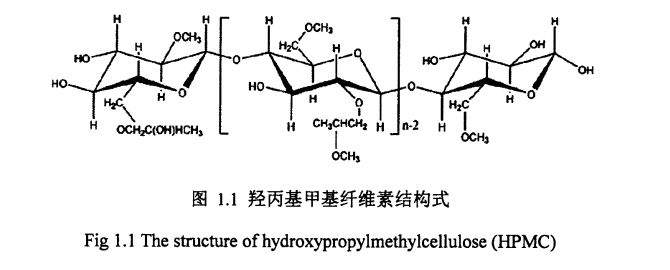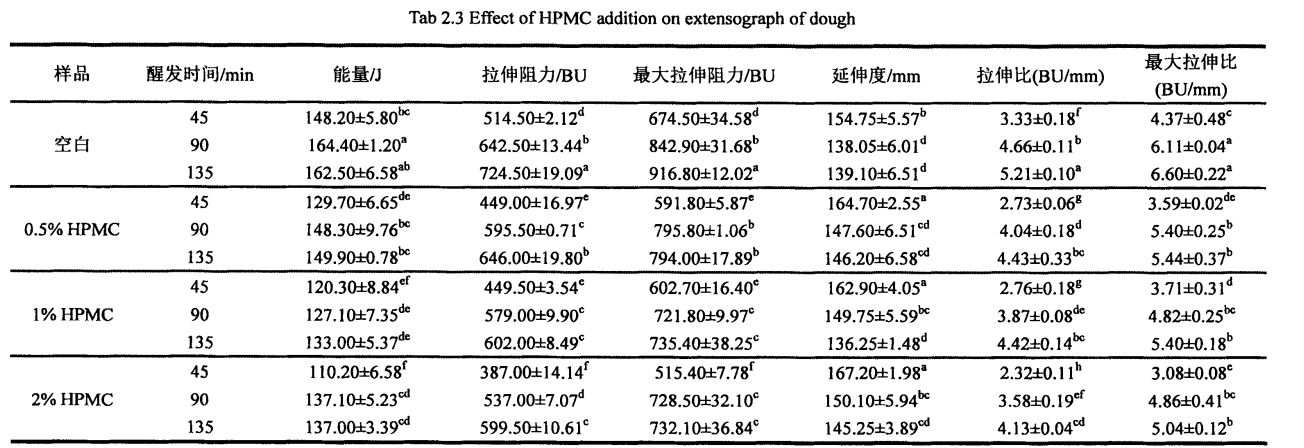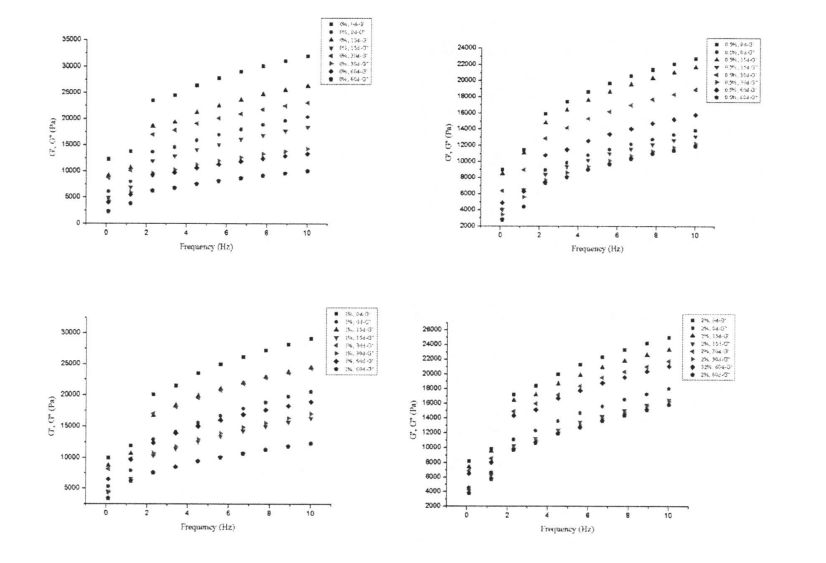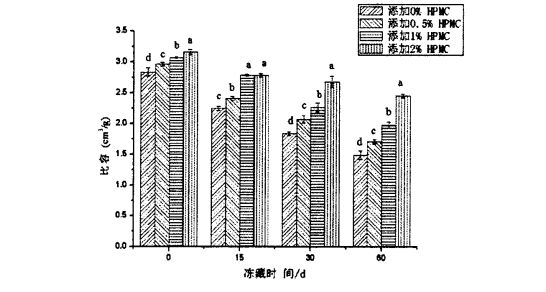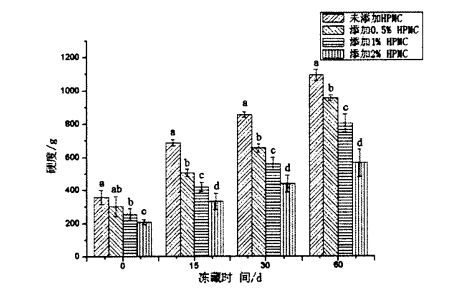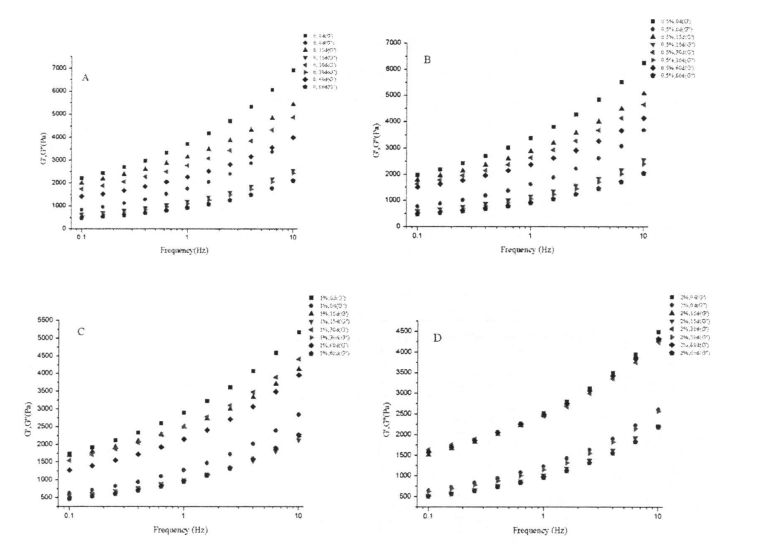Improving the processing properties of frozen dough has certain practical significance for realizing large-scale production of high-quality convenient steamed bread. ໃນການສຶກສາຄັ້ງນີ້, ປະເພດໃຫມ່ຂອງ colloid hydrophilic (hydroxypropropylinkyllose, ຍາງ, mc) ໄດ້ຖືກນໍາໃຊ້ກັບ dough frozen. ຜົນກະທົບຂອງ 0.5%, 1%, 2%) ໃນຄຸນລັກສະນະຂອງການປຸງແຕ່ງຂອງ dough frozen ແລະຄຸນນະພາບຂອງເຂົ້າຈີ່ເຂົ້າຈີ່ໄດ້ຖືກປະເມີນຜົນເພື່ອປະເມີນຜົນຂອງການປັບປຸງຂອງ HPMC. ມີອິດທິພົນຕໍ່ໂຄງສ້າງແລະຄຸນສົມບັດຂອງສ່ວນປະກອບ (ເຂົ້າສາລີ Gluten, ທາດແປ້ງສາລີ, ເຊື້ອລາແລະເຊື້ອລາ).
ຄໍາສໍາຄັນ: ເຂົ້າຈີ່ຫນື້ງ; dough frozen; hydroxypropropylinkyl methylcellulose; ເຂົ້າຫນົມປັງເຂົ້າ Wheat; ທາດແປ້ງເຂົ້າສາລີ; ເຊື້ອລາ.
ສາລະບານ
1.1.3 ການແນະນໍາ Dough Frozen ..........................................................................................................................................................................................
1.1.5 ສະຖານະການຄົ້ນຄ້ວາຂອງ dough frozen .............................................. . ................................................. 4
1.1.7 Hydroxypropyl methyl cellulose (Hydroxypropyl methyl cellulose, I-IPMC) ………. 5
112 ຈຸດປະສົງແລະຄວາມສໍາຄັນຂອງການສຶກສາ ....................................................................................6
1.3 ເນື້ອໃນຫຼັກຂອງການສຶກສາ........................................................................................................................а
2.2 ວັດສະດຸທີ່ມີການທົດລອງແລະວິທີການ ....................................................................................................8
2.3 Experimental results and discussion…………………………………………………………………… . ດ້ວຢເຫລືອ
2.3.1 ດັດສະນີຂອງສ່ວນປະກອບພື້ນຖານຂອງແປ້ງສາລີ ................................................................................ .1l
2.3.3 ຜົນກະທົບຂອງການເພີ່ມເຕີມຂອງ HPMC ກ່ຽວກັບຄຸນສົມບັດທີ່ເຄັ່ງຄັດຂອງ dough .................................. 12
2.4 Chapter Summary ..........................................................................................................................21
3.2.2 ເຄື່ອງມືທົດລອງ........................................................................................................................................................................................................................................а
3.2.3 reagents ທົດລອງ ........................................................................................................ . .................. 25
3.2.4 ວິທີການທົດລອງ ....................................................................................................................................................................................... ການ
3.3.2 The effect of adding amount of HPMC and freezing storage time on the freezable moisture content (CFW) and thermal stability……………………………………………………………………. 30
3.3.3 Effects of HPMC addition amount and freezing storage time on free sulfhydryl content (C vessel) …………………………………………………………………………………………………………. . 34
3.3.4 ຜົນກະທົບຂອງຈໍານວນການເພີ່ມເຕີມຂອງ HPMC ແລະເວລາໃນການເກັບຮັກສາຄວາມຊຸ່ມຊື່ນ (n)
3,3,5 ຜົນກະທົບຂອງຈໍານວນການເພີ່ມເຕີມຂອງ HPMC ແລະການເກັບຮັກສາເວລາທີ່ມີຄວາມຮັກແພງ
3.3.6 ຜົນກະທົບຂອງຈໍານວນການເພີ່ມຂອງ fipmc ແລະເວລາທີ່ຫນາວເຢັນຢູ່ເທິງພື້ນຜິວທີ່ມີທາດໂປຼຕີນ
3.4 Chapter Summary ......................................................................................................................... 43
4.1 Introduction .............................................................................................................................. . 44
4.2 Experimental materials and methods ................................................................................. 45
4.2.2 ເຄື່ອງໃຊ້ທົດລອງ ....................................................................................................................................4
4.2.3 ວິທີການທົດລອງ ........................................................................................................................................................45
4.3 Analysis and discussion ........................................................................................................... 48
4.3.1 Content of basic components of wheat starch ……………………………………………………. 48
4.3.3 ຜົນກະທົບຂອງການເພີ່ມ HPMC ແລະເວລາການເກັບຮັກສາທີ່ຫນາວເຢັນໃນຄວາມເປັນມາຂອງທາດແປ້ງ ................................................................................................................................................................................................................................................................................................................................................................................................................................................................................................................................................................................................................................................................................................................................... .). 52
4.3.6 Effects of I-IPMC addition amount and frozen storage time on the thermodynamic properties of starch ………………………………………………………………………………………………………. . ເລກ 57
ບົດທີ 5 ຜົນກະທົບຂອງການເພີ່ມເຕີມ HPMC ກ່ຽວກັບກິດຈະກໍາແລະກິດຈະກໍາການຫມັກຂອງເຊື້ອອາວືດພາຍໃຕ້ເງື່ອນໄຂການເກັບຮັກສາອາການຮ້ອນ .................................................................. . . 62
5.1Introduction .................................................................................................................................... 62
5.2 Materials and methods ............................................................................................................ 62
5.2.1 ອຸປະກອນການທົດລອງແລະເຄື່ອງມື ............................................................................................
5.2.2 Experimental methods . . . . . …………………………………………………………………………. 53
5.3 Results and Discussion ............................................................................................................... 54
5.3.3 The effect of adding amount of HPMC and freezing time on the content of glutathione in dough……………………………………………………………………………………………………………66. "
5.4 Chapter Summary ........................................................................................................................ 67
ບົດທີ 6 ບົດສະຫຼຸບແລະຄວາມສົດໃສດ້ານ ............................................................................................................................ ......... 68
6.1 Conclusion ................................................................................................................................. . ສະພາເພັດ 68
6.2 Outlook .......................................................................................................................................... ສະພາເພັດ 68
ບັນຊີລາຍຊື່ຂອງຮູບແຕ້ມ
Figure 1.1 The structural formula of hydroxypropyl methylcellulose………………………. . 6
Figure 2.4 The effect of HPMC addition and freezing time on the elasticity of steamed bread………………………………………………………………………………………………………………………………. . ດ້ວຢ 20
Figure 3.1 The effect of HPMC addition and freezing time on the rheological properties of wet gluten…………………………………………………………………………………………………………………………. 30
Figure 3.2 Effects of HPMC addition and freezing time on the thermodynamic properties of wheat gluten………………………………………………………………………………………………………………. . 34
Figure 3.3 Effects of HPMC addition and freezing time on free sulfhydryl content of wheat gluten……………………………………………………………………………………………………………………………... . 35
Figure 3.7 The effect of HPMC addition and freezing time on the microscopic gluten network structure…………………………………………………………………………………………………………... . 43
Figure 4.1 Starch gelatinization characteristic curve ............................................................... 51
Figure 4.2 Fluid thixotropy of starch paste ................................................................................. 52
Figure 4.3 Effects of adding amount of MC and freezing time on the viscoelasticity of starch paste……………………………………………………………………………………………………………………... . ເລກ 57
ຮູບສະແດງຂໍ້ມູນເພີ່ມເຕີມຂອງ HPMC. . ປິ້ງ 59
Figure 5.2 The effect of HPMC addition and freezing time on the yeast survival rate…………………………………………………………………………………………………………………………………... . 67
Figure 5.3 Microscopic observation of yeast (microscopic examination) …………………………………………………………………………………………………………………………. ສະພາເພັດ 68
ຕາຕະລາງ 2.1 ເນື້ອໃນສ່ວນປະກອບພື້ນຖານຂອງແປ້ງສາລີ ............................................................................... . ດ້ວຢເຫລືອ
Table 3.2 Effects of I-IPMC addition amount and freezing storage time on the phase transition enthalpy (Yi IV) and freezer water content (e chat) of wet gluten………………………. 31
Table 3.3 Effects of HPMC addition amount and freezing storage time on the peak temperature (product) of thermal denaturation of wheat gluten…………………………………………. 33
Table 3.6 Effects of I-IPMC addition and freezing storage time on the surface hydrophobicity of wheat gluten……………………………………………………………………………………………. 41
Table 4.3 Effects of I-IPMC addition and freezing time on the shear viscosity of wheat starch paste…………………………………………………………………………………………………………………………. 55
ບົດທີ 1 ຄໍາແນະນໍາ
2) ການຄົ້ນຄວ້າກ່ຽວກັບການປຸງແຕ່ງແລະການປະສົມແປ້ງທີ່ເປັນພິເສດສໍາລັບເຂົ້າຈີ່ຫນື້ງ. ຜົນກະທົບຂອງທາດແປ້ງກ່ຽວກັບຄຸນນະພາບຂອງແປ້ງແລະຫນື້ງແລະການຄົ້ນຄ້ວາເຂົ້າຫນົມໃຫມ່, ແລະອີງໃສ່ຮູບແບບການປະເມີນຄວາມເຫມາະສົມຂອງແປ້ງໄດ້ຖືກສ້າງຕັ້ງຂື້ນ [7]; for example, the effects of different flour milling methods on the quality of flour and steamed buns[7] 81; The effect of the compounding of several waxy wheat flours on the quality of steamed bread [9J et al.; Zhu, Huang, &Khan (2001) evaluated the effect of wheat protein on the quality of dough and northern steamed bread, and considered that gliadin/ Glutenin was significantly negatively correlated with dough properties and steamed bread quality [lo]; Zhang, et a1. (2007) analyzed the correlation between gluten protein content, protein type, dough properties and steamed bread quality, and concluded that the content of high molecular weight glutenin subunit (1ligh.molecular-weight, HMW) and total protein content are all related to the quality of northern steamed bread. have a significant impact [11].
3)Research on dough preparation and steamed bread making technology. Research on the influence of steamed bread production process conditions on its quality and process optimization; Liu Changhong et al. (2009) showed that in the process of dough conditioning, process parameters such as water addition, dough mixing time, and dough pH value have an impact on the whiteness value of steamed bread. It has a significant impact on sensory evaluation. If the process conditions are not suitable, it will cause the product to turn blue, dark or yellow. The research results show that during the dough preparation process, the amount of water added reaches 45%, and the dough mixing time is 5 minutes, ~ When the pH value of the dough was 6.5 for 10 min, the whiteness value and sensory evaluation of the steamed buns measured by the whiteness meter were the best. When rolling the dough 15-20 times at the same time, the dough is flaky, smooth, elastic and shiny surface; when the rolling ratio is 3:1, the dough sheet is shiny, and the whiteness of the steamed bread increases [l to; Li, ET A1. (2015) explored the production process of compound fermented dough and its application in steamed bread processing [13].
6)Research on the application of new fermented bacteria and sourdough. Jiang, et a1. (2010) Application of Chaetomium sp. fermented to produce xylanase (with thermostable) in steamed bread [2l'; Gerez, et a1. (2012) used two kinds of lactic acid bacteria in fermented flour products and evaluated their quality [221; Wu, et al. (2012) studied the influence of sourdough fermented by four kinds of lactic acid bacteria (Lactobacillus plantarum, Lactobacillus, sanfranciscemis , Lactobacillus brevis and Lactobacillus delbrueckii subsp bulgaricus) on the quality (specific volume, texture, fermentation flavor, etc.) of northern steamed bread [23]; ແລະ gerez, et a1. (2012) ໃຊ້ຄຸນລັກສະນະການຫມັກຂອງເຊື້ອແບັກທີເຣັຍທີ່ມີອາຊິດສອງຊະນິດເພື່ອເລັ່ງ hydrolysis ຂອງ Gliadin ເພື່ອຫຼຸດຜ່ອນອາການແພ້ຜະລິດຕະພັນແປ້ງ [24].
Among them, steamed bread is prone to aging under conventional storage conditions, which is an important factor restricting the development of steamed bread production and processing industrialization. After aging, the quality of steamed bread is reduced - the texture becomes dry and hard, dregs, shrinks and cracks, the sensory quality and flavor deteriorate, the digestion and absorption rate decreases, and the nutritional value decreases. ນີ້ບໍ່ພຽງແຕ່ມີຜົນກະທົບຕໍ່ຊີວິດຂອງມັນເທົ່ານັ້ນ, ແຕ່ຍັງສ້າງສິ່ງເສດເຫຼືອຫຼາຍ. ອີງຕາມສະຖິຕິ, ການສູນເສຍປະຈໍາປີເນື່ອງຈາກແກ່ຜູ້ສູງອາຍຸແມ່ນ 3% ຂອງຜະລິດຕະພັນແປ້ງ. 7%. With the improvement of people's living standards and health awareness, as well as the rapid development of the food industry, how to industrialize the traditional popular staple noodle products including steamed bread, and obtain products with high quality, long shelf life and easy preservation to meet the needs of the growing demand for fresh, safe, high-quality and convenient food is a long-standing technical problem. Based on this background, frozen dough came into being, and its development is still in the ascendant.
ອີງຕາມຂະບວນການຜະລິດ, dough ແຊ່ແຂງສາມາດແບ່ງອອກເປັນສີ່ປະເພດ.
Cakes and other pasta products have different degrees of application [26-27]. According to incomplete statistics, by 1990, 80% of bakeries in the United States used frozen dough; 50% ຂອງ bakerries ໃນປະເທດຍີ່ປຸ່ນຍັງໄດ້ໃຊ້ dough frozen. ສະຕະວັດທີ 20
ເຕັກໂນໂລຍີທີ່ຫນາວເຢັນທີ່ສະຫນອງຄວາມຄິດທີ່ເປັນໄປໄດ້ສໍາລັບການຜະລິດອາຫານພື້ນເມືອງຂອງຈີນເຊັ່ນເຂົ້າຈີ່ຫນື້ງ. However, this processing technology still has some shortcomings, especially under the condition of longer freezing time, the final product will have longer proofing time, lower specific volume, higher hardness, Water loss, poor taste, reduced flavor, and quality deterioration. In addition, due to freezing
Most studies have found that the formation and growth of ice crystals in frozen foods is an important factor leading to the deterioration of product quality [291]. ໄປເຊຍກ້ອນບໍ່ພຽງແຕ່ຫຼຸດຜ່ອນອັດຕາການຢູ່ລອດຂອງຄວາມແຮງແລະຄວາມເສຍຫາຍຂອງຈຸລັງທີ່ເຮັດໃຫ້ນ້ໍາເຂົ້າຫນຽວແລະປ່ອຍເຂົ້າຫນຽວທີ່ຈະຫຼຸດຜ່ອນຄວາມສາມາດໃນອາຍແກຣດ In addition, in the case of frozen storage, temperature fluctuations can cause ice crystals to grow due to recrystallization [30]. Therefore, how to control the adverse effects of ice crystal formation and growth on starch, gluten and yeast is the key to solving the above problems, and it is also a hot research field and direction. In the past ten years, many researchers have been engaged in this work and achieved some fruitful research results. However, there are still some gaps and some unresolved and controversial issues in this field, which need to be further explored, such as:
i.study ການປ່ຽນແປງຂອງໂຄງສ້າງແລະຄຸນສົມບັດຂອງການຂະຫຍາຍເວລາການເກັບຮັກສາທີ່ມີຄວາມເສື່ອມໂຊມ, ໂດຍສະເພາະ, ທາດແປ້ງ, ແລະອື່ນໆ). Formation and growth and its relationship with water state and distribution; changes in wheat gluten protein structure, conformation and properties [31]; changes in starch structure and properties; changes in dough microstructure and related properties, etc. 361.
ການສຶກສາໄດ້ສະແດງໃຫ້ເຫັນວ່າເຫດຜົນຫຼັກໆສໍາລັບການເສື່ອມສະພາບຂອງແປ້ງເຂົ້າຫນົມປັງປະກອບມີ: 1) ໃນຂະບວນການລອຍນໍ້າ, ກິດຈະກໍາເຊື້ອລາແລະການຫມັກຂອງມັນຫຼຸດລົງຢ່າງຫຼວງຫຼາຍ; 2) The continuous and complete network structure of the dough is destroyed, resulting in the air holding capacity of the dough. and the structural strength is greatly reduced.
II. Optimization of frozen dough production process, frozen storage conditions and formula. During the production of frozen dough, temperature control, proofing conditions, pre-freezing treatment, freezing rate, freezing conditions, moisture content, gluten protein content, and thawing methods will all affect the processing properties of frozen dough [37]. In general, higher freezing rates produce ice crystals that are smaller in size and more uniformly distributed, while lower freezing rates produce larger ice crystals that are not uniformly distributed. In addition, a lower freezing temperature even below the glass transition temperature (CTA) can effectively maintain its quality, but the cost is higher, and the actual production and cold chain transportation temperatures are usually small. In addition, the fluctuation of the freezing temperature will cause recrystallization, which will affect the quality of the dough.
III. Using additives to improve the product quality of frozen dough. In order to improve the product quality of frozen dough, many researchers have made explorations from different perspectives, for example, improving the low temperature tolerance of material components in frozen dough, using additives to maintain the stability of the dough network structure [45.56], etc. Among them, the use of additives is an effective and widely used method. ສ່ວນໃຫຍ່ປະກອບມີ, i) ການກະກຽມ enzyme, ເຊັ່ນວ່າ, transglutaminase, o [. Amylase; ii) emulsifiers, such as monoglyceride stearate, DATEM, SSL, CSL, DATEM, etc.; iii) antioxidants, ascorbic acid, etc.; IV) hydrocolloids polysaccharide ເຊັ່ນ: gum Guar, ຕົ້ນສະບັບສີເຫຼືອງ, gum arabic, gum konjac, alcom sodium, ແລະອື່ນໆ; v) ສານອື່ນໆທີ່ມີປະໂຫຍດ, ເຊັ່ນວ່າ XU, ET A1. (2009) added Ice-structuring Proteins to wet gluten mass under freezing conditions, and studied its protective effect and mechanism on the structure and function of gluten protein [y71.
The chemical nature of hydrocolloid is a polysaccharide, which is composed of monosaccharides (glucose, rhamnose, arabinose, mannose, etc.) through 0 [. 1-4. Glycosidic bond or/and a. 1--"6. Glycosidic bond or B. 1-4. Glycosidic bond and 0 [.1-3. The high molecular organic compound formed by the condensation of glycosidic bond has a rich variety and can be roughly divided into: ① Cellulose derivatives , such as methyl cellulose (MC), carboxymethyl cellulose (CMC); ② plant polysaccharides, such as konjac gum, guar gum, gum Arabic ; ③ seaweed polysaccharides, such as seaweed gum, carrageenan; ④ microbial polysaccharides, such as Xanthan gum .Polysaccharide has strong hydrophilicity because it contains a large number of hydroxyl groups that are easy to form hydrogen bonds with water, and has the functions of controlling the migration, state and distribution of water in the food system. Therefore, the addition of hydrophilic colloids gives food Many functions, properties, and qualities of hydrocolloids are closely related to the interaction between polysaccharides and water and other macromolecular substances. At the same time, due to the multiple functions of thickening, stabilizing, and water retention, Hydrocolloids ແມ່ນຖືກນໍາໃຊ້ຢ່າງກວ້າງຂວາງເພື່ອປະກອບເຂົ້າໃນການປຸງແຕ່ງອາຫານຂອງຜະລິດຕະພັນແປ້ງ. Wang xin et al. (2007) studied the effect of adding seaweed polysaccharides and gelatin on the glass transition temperature of dough [631. Wang Yusheng et al. (2013) believed that compound addition of a variety of hydrophilic colloids can significantly change the flow of dough. Change the properties, improve the tensile strength of the dough, enhance the elasticity of the dough, but reduce the extensibility of the dough [delete.
1.1.7hydroxyproyproproproproproproproproproproproprople cellulose (hydroxyproproproproplinkyl cellulose, i-ipmc)
Hydroxypropropylinkl Methyl methyl methyl methyl cellulose, hypc metulose ທີ່ເກີດຂື້ນໂດຍ hydroxypropropropropyl ແລະ methyl ທີ່ປ່ຽນແທນ Hydroxyl ໃນລະບົບຕ່ອງໂສ້ດ້ານຂ້າງຂອງ Cellulose [65] (ຮູບ 1). ສະຫະລັດອາເມລິກາ PhapiaCaCa (ສະຫະລັດ)
Although HPMC has been used in pasta to a certain extent, it is mainly used as an anti-aging agent and water-retaining agent for bread, etc., which can improve product specific volume, texture properties and prolong shelf life [71.74]. ເຖິງຢ່າງໃດກໍ່ຕາມ, ເມື່ອປຽບທຽບກັບ colloids hydrophilic ເຊັ່ນ Guar Gum, Xanthan gum, ບໍ່ມີການສຶກສາກ່ຽວກັບ dikzc ໃນ dpmc, ບໍ່ວ່າຈະປັບປຸງຄຸນນະພາບຂອງເຂົ້າຈີ່ທີ່ຖືກປຸງແຕ່ງຈາກ dough frozen. There is still a lack of relevant reports on its effect.
At present, the application and large-scale production of frozen dough processing technology in my country as a whole is still in the development stage. At the same time, there are certain pitfalls and deficiencies in the frozen dough itself. These comprehensive factors undoubtedly restrict the further application and promotion of frozen dough. on the other hand,this also means that the application of frozen dough has great potential and broad prospects, especially from the perspective of combining frozen dough technology with the industrialized production of traditional Chinese noodles (non-)fermented staple food, to develop more products that meet the needs of Chinese residents. ມັນມີຄວາມສໍາຄັນທີ່ເປັນປະໂຫຍດເພື່ອປັບປຸງຄຸນນະພາບຂອງແປ້ງແຊ່ແຂງໂດຍອີງໃສ່ຄຸນລັກສະນະຂອງ pastry ຈີນແລະນິໄສກ່ຽວກັບອາຫານ, ແລະເຫມາະສົມກັບຄຸນລັກສະນະຂອງການປຸງແຕ່ງຂອງ pastry ຂອງຈີນ.
1.3 ເນື້ອໃນຕົ້ນຕໍຂອງການສຶກສາ
Effects of addition amount and frozen storage time on the structure and properties of frozen dough, the quality of frozen dough products (steamed bread), the structure and properties of wheat gluten, the structure and properties of wheat starch, and the fermentation activity of yeast. ອີງໃສ່ການພິຈາລະນາດ້ານເທິງນີ້, ການອອກແບບທົດລອງດັ່ງຕໍ່ໄປນີ້ໄດ້ຖືກສ້າງຂື້ນໃນຫົວຂໍ້ຄົ້ນຄ້ວານີ້:
1) ເລືອກປະເພດຂອງ hydrophilic ຂອງ hydrophilic (hydroxypropylinkyl metzylcose (HydroxypropylinkloSlose ເປັນເວລາສໍາລັບການເພີ່ມເຕີມຂອງ HPMC ພາຍໃຕ້ສະພາບການເພີ່ມເຕີມ (0, 30, 60, (0%, 0.5%, 1%, 2%; the same below) on the rheological properties and microstructure of frozen dough, as well as on the quality of the dough product - steamed bread (including the specific volume of steamed bread) , texture), investigate the effect of adding HPMC to the frozen dough on the processing properties of the dough and the quality of steamed bread, and evaluate the improvement effect of HPMC on the processing properties of the frozen dough;
3) ຈາກທັດສະນະຂອງກົນໄກການປັບປຸງ, ຜົນກະທົບຂອງການເພີ່ມເຕີມຂອງ HPMC, ຄຸນສົມບັດຂອງ geltinization, ແລະຄຸນສົມບັດຂອງທາດແປ້ງທີ່ແຕກຕ່າງກັນຂອງສະພາບເວລາໃນການເກັບຮັກສາທີ່ແຕກຕ່າງກັນ.
Generally speaking, the material composition of dough used for making fermented flour products mainly includes biological macromolecular substances (starch, protein), inorganic water, and yeast of organisms, and is formed after hydration, cross-linking and interaction. A stable and complex material system with a special structure has been developed. ການສຶກສາຈໍານວນຫລາຍໄດ້ສະແດງໃຫ້ເຫັນວ່າຄຸນສົມບັດຂອງ dough ມີຜົນກະທົບທີ່ສໍາຄັນຕໍ່ຄຸນນະພາບຂອງຜະລິດຕະພັນສຸດທ້າຍ. Therefore, by optimizing the compounding to meet the specific product and it is a research direction to improve the dough formulation and technology of the quality of the product or food for use; on the other hand, improving or improving the properties of dough processing and preservation to ensure or improve the quality of the product is also an important research issue.
2.2 ວັດສະດຸທົດລອງແລະວິທີການ
Zhongyu Wheat Flour Binzhou Zhongyu Food Co., Ltd.; Angel Active Dry Yeast Angel Yeast Co., Ltd.; HPMC (methyl substitution degree of 28%.30%, hydroxypropyl substitution degree of 7%.12%) Aladdin (Shanghai) Chemical Reagent Company; ທັງຫມົດສານເຄມີທີ່ໃຊ້ໃນການທົດລອງນີ້ແມ່ນຂອງລະດັບການວິເຄາະ;
2.2.2 ເຄື່ອງມືທົດລອງແລະອຸປະກອນທົດລອງ
BPS. 500CL ອຸນຫະພູມອຸນຫະພູມແລະກ່ອງຄວາມຊຸ່ມຊື່ນ
DHG. 9070A Blast Drying Oven
Powder meter. ເປັນ
Extensometer. ເປັນ
Discovery R3 Ridation Ridation Ridation
Q200 ແຄລໍລີ່ສະແກນທີ່ແຕກຕ່າງກັນ
FD. 1B. 50 ເຄື່ອງອົບແຫ້ງ
ເຕົາໄຟ Sx2.4.10 Muffle
ຜູ້ຜະລິດ
ລະບົບການ micro stab, ອັງກິດ
ບໍລິສັດບໍລິສັດຜະລິດເຄື່ອງໃຊ້ຊີວິດ Guangdod Midea Life, Ltd.
ບໍລິສັດອາເມລິກາ
ບໍລິສັດອາເມລິກາ
ບໍລິສັດ Foss Danish
2.2.3.1 ການກໍານົດສ່ວນປະກອບພື້ນຖານຂອງແປ້ງ
2.2.3.3 ການກໍານົດຄຸນລັກສະນະຂອງຄວາມຫນາແຫນ້ນຂອງ dough
ເອົາຕົວຢ່າງ dough ອອກຫຼັງຈາກເວລາທີ່ຫນາວເຢັນ, ໃຫ້ພວກມັນຢູ່ໃນຕູ້ເຢັນທີ່ 4 ° C ສໍາລັບອຸນຫະພູມ 4 ຊົ່ວໂມງຈົນກ່ວາຕົວຢ່າງໃນຫ້ອງແມ່ນ melted ຫມົດ. The sample processing method is also applicable to the experimental part of 2.3.6.
2.2.3.6 ເນື້ອໃນຂອງນ້ໍາທີ່ບໍ່ສາມາດໃຊ້ໄດ້ (ເນື້ອໃນຂອງນ້ໍາທີ່ທັນສະໄຫມ, ການກໍານົດພາຍໃນຂອງ CF) ໃນ dough
ໃນນັ້ນ, 厶ສະແດງເຖິງຄວາມຮ້ອນທີ່ຮ້ອນຂອງຄວາມຊຸ່ມ, ແລະຄຸນຄ່າຂອງມັນແມ່ນ 334 J Dan; MC (total Moisture Content) represents the total moisture content in the dough (measured according to GB 50093.2010t78]). Each sample was repeated three times.
2.2.3.7 ການຜະລິດເຂົ້າຈີ່ຫນື້ງ
ຫຼັງຈາກເວລາທີ່ຫນາວເຢັນທີ່ສອດຄ້ອງກັນໄດ້ຖືກເອົາອອກ, ມີຄວາມສົມດຸນທໍາອິດໃນຕູ້ເຢັນ 4 ° C ໃນອຸນຫະພູມ 4 ຊົ່ວໂມງຈົນກ່ວາ dough ໃນຫ້ອງຈົນກ່ວາ dough ຫນາວເຢັນ. ແບ່ງ dough ເຂົ້າໄປໃນປະມານ 70 ກຼາມຕໍ່ສ່ວນ, ໃຫ້ຊອຍເປັນຮູບຮ່າງ, ແລະເອົາມັນໃສ່ໃນປ່ອງທີ່ອຸນຫະພູມແລະຄວາມຊຸ່ມຊື່ນໃນເວລາ 60 ° C ແລະຄວາມຊຸ່ມຊື່ນຂອງ 85%. After proofing, steam for 20 min, and then cool for 1 h at room temperature to evaluate the quality of steamed bread.
(1) ການກໍານົດປະລິມານສະເພາະຂອງເຂົ້າຈີ່ຫນື້ງ
ອີງຕາມ GB / T 20981.2007 [871, ວິທີການຍ້າຍຖິ່ນຖານທີ່ຖືກຂົ່ມຂືນໄດ້ຖືກວັດແທກຂອງເຂົ້າຫນົມປັງ, ແລະມວນ (ມ) ຂອງເຂົ້າຫນົມປັງແມ່ນວັດແທກໂດຍໃຊ້ຄວາມສົມດຸນທາງອີເລັກໂທຣນິກ. Each sample was replicated three times.
ດັດສະນີສ່ວນປະກອບພື້ນຖານຂອງແປ້ງສາລີ
TAB 2.1 ເນື້ອໃນຂອງການປະກອບຂອງທາດແປ້ງເຂົ້າສາລີ
2.3.2 ຜົນກະທົບຂອງການເພີ່ມເຕີມ I-ipmc ກ່ຽວກັບຄຸນສົມບັດ farinaceous ຂອງ dough
The tensile properties of the dough can better reflect the processing properties of the dough after proofing, including the extensibility, tensile resistance and stretch ratio of the dough. The tensile properties of the dough are attributed to the extension of the glutenin molecules in the dough extensibility, as the cross-linking of glutenin molecular chains determines the elasticity of the dough [921]. Termonia, Smith (1987) [93] believed that the elongation of polymers depends on two chemical kinetic processes, that is, the breaking of secondary bonds between molecular chains and the deformation of cross-linked molecular chains. When the deformation rate of the molecular chain is relatively low, the molecular chain cannot sufficiently and quickly cope with the stress generated by the stretching of the molecular chain, which in turn leads to the breakage of the molecular chain, and the extension length of the molecular chain is also short. ພຽງແຕ່ໃນເວລາທີ່ອັດຕາການຜິດປົກກະຕິຂອງລະບົບຕ່ອງໂສ້ໂມເລກຸນສາມາດພິເສດໄດ້ວ່າລະບົບຕ່ອງໂສ້ໂມເລກຸນສາມາດພິການໄດ້ໂດຍໄວແລະມີຄວາມສາມາດໃນລະບົບຕ່ອງໂສ້ໂມເລກຸນຈະບໍ່ຖືກເພີ່ມຂື້ນ. ເພາະສະນັ້ນ, ການປ່ຽນແປງພຶດຕິກໍາການເສື່ອມສະພາບຂອງລະບົບຕ່ອງໂສ້ທາດໂປຼຕີນຂອງທາດໂປຼຕີນຈາກ gluten ຈະມີຜົນກະທົບຕໍ່ຄຸນລັກສະນະທີ່ຫນາແຫນ້ນຂອງ dough [92].
ຕາຕະລາງ 2.3 ລາຍຊື່ຜົນກະທົບຂອງປະລິມານທີ່ແຕກຕ່າງກັນຂອງ HPMC (O, 0.5%, 1% (90%, 1% (90%, 1% (90%, ຕ້ານທານ, ການຕ້ານທານ The experimental results show that the tensile properties of all dough samples increase with the extension of the proofing time except the elongation which decreases with the extension of the proofing time. For the energy value, from 0 to 90 min, the energy value of the rest of the dough samples increased gradually except for the addition of 1% HPMC, and the energy value of all dough samples increased gradually. There were no significant changes. This shows that when the proofing time is 90 min, the network structure of the dough (cross-linking between molecular chains) is completely formed. Therefore, the proofing time is further extended, and there is no significant difference in the energy value. At the same time, this can also provide a reference for determining the proofing time of the dough. ໃນຖານະເປັນເວລາທີ່ພິສູດເຖິງເວລາດົນນານ, ພັນທະບັດທີ່ມີຄວາມສາມາດຫຼາຍຂື້ນລະຫວ່າງຕ່ອງໂສ້ໂມເລກຸນໄດ້ຖືກສ້າງຕັ້ງຂຶ້ນແລະຄວາມຕ້ານທານຂອງໂມເລກຸນແມ່ນມີຄວາມຕ້ານທານຫຼາຍກວ່າເກົ່າ, ສະນັ້ນຄວາມຕ້ານທານ tensile ແລະຄວາມຕ້ານທານ tensile ສູງສຸດເພີ່ມຂື້ນ. At the same time, the deformation rate of molecular chains also decreased with the increase of secondary bonds between molecular chains and the tighter cross-linking of molecular chains, which led to the decrease of the elongation of the dough with the excessive extension of the proofing time. The increase in tensile resistance/maximum tensile resistance and the decrease in elongation resulted in an increase in tensile LL/maximum tensile ratio.
J (2% HPMC added). ໃນເວລາດຽວກັນ, ຄວາມຕ້ານທານຄວາມຮ້ອນສູງສຸດຂອງ dough ຫຼຸດລົງຈາກ 674.58 bu (1% hpmc), ແລະ 515,40-a: 7.78 bu (2% bu (2% HPMC However, the elongation of the dough increased from 154.75+7.57 MITI (blank) to 164.70-a: 2.55 m/rl(adding 0.5% HPMC), 162.90-a: 4 .05 min (1% HPMC added), and 1 67.20-a: 1.98 min (2% HPMC added). This may be due to the increase of the plasticizer-water content by adding HPMC, which reduces the resistance to the deformation of the gluten protein molecular chain, or the interaction between HPMC and the gluten protein molecular chain changes its stretching behavior, which in turn affects It improves the tensile properties of the dough and increases the extensibility of the dough, which will affect the quality (eg, specific volume, texture) of the final product.
Figure 2.1 shows the change of storage modulus (elastic modulus, G') and loss modulus (viscous modulus, G") of dough with different HPMC content from 0 days to 60 days. The results showed that with the prolongation of freezing storage time, the G' of the dough without adding HPMC decreased significantly, while the change of G" was relatively small, and the /an Q (G''/G') increased. ນີ້ອາດຈະແມ່ນຍ້ອນຄວາມຈິງທີ່ວ່າໂຄງສ້າງເຄືອຂ່າຍຂອງ dough ແມ່ນເສຍຫາຍຈາກບ່ອນເກັບມ້ຽນນ້ໍາກ້ອນໃນລະຫວ່າງການເກັບຮັກສາໂຄງສ້າງແລະດັ່ງນັ້ນ modulus elastic ຫຼຸດລົງຢ່າງຫຼວງຫຼາຍ. ເຖິງຢ່າງໃດກໍ່ຕາມ, ດ້ວຍການເພີ່ມຂື້ນຂອງການເພີ່ມ HPMC, ການປ່ຽນແປງຂອງ g 'ຄ່ອຍໆຫຼຸດລົງ. ໂດຍສະເພາະ, ເມື່ອຈໍານວນເງິນ HPMC ເພີ່ມຂື້ນ 2%, ການປ່ຽນແປງຂອງ g 'ແມ່ນນ້ອຍທີ່ສຸດ. This shows that HPMC can effectively inhibit the formation of ice crystals and the increase in the size of ice crystals, thereby reducing the damage to the dough structure and maintaining the structural strength of the dough. In addition, the G' value of dough is greater than that of wet gluten dough, while the G" value of dough is smaller than that of wet gluten dough, mainly because the dough contains a large amount of starch, which can be adsorbed and dispersed on the gluten network structure. It increases its strength while retaining excess moisture.
ບໍ່ແມ່ນຄວາມຊຸ່ມຊື້ນທັງຫມົດໃນ dough ສາມາດປະກອບເປັນນ້ໍາກ້ອນໃນອຸນຫະພູມຕ່ໍາທີ່ແນ່ນອນ, ເຊິ່ງມີຄວາມຊຸ່ມຊື້ນ (ບໍ່ມີການຈໍາກັດ, ປະສົມປະສານກັບສານອື່ນໆ, ແລະສະພາບແວດລ້ອມ. Freezable water is the water in the dough that can undergo phase transformation to form ice crystals at low temperatures. ຈໍານວນນ້ໍາທີ່ບໍ່ສາມາດສົ່ງຜົນກະທົບຕໍ່ຈໍານວນ, ຂະຫນາດແລະການແຈກຢາຍຂອງການສ້າງປະມານໄປເຊຍກ້ອນ. ນອກຈາກນັ້ນ, ເນື້ອໃນຂອງນ້ໍາທີ່ບໍ່ສາມາດໃຊ້ໄດ້ກໍ່ໄດ້ຮັບຜົນກະທົບຈາກການປ່ຽນແປງສິ່ງແວດລ້ອມ, ເຊັ່ນ: ການຂະຫຍາຍເວລາເກັບຮັກສາທີ່ທັນສະໄຫມ, ການປ່ຽນແປງຂອງອຸນຫະພູມການເກັບຮັກສາອາກາດຫນາວເຢັນ, ແລະຄຸນສົມບັດຂອງລະບົບວັດສະດຸແລະຄຸນສົມບັດ. For the frozen dough without added HPMC, with the prolongation of freezing storage time, Q silicon increased significantly, from 32.48±0.32% (frozen storage for 0 days) to 39.13±0.64% (frozen storage for 0 days). Tibetan for 60 days), the increase rate was 20.47%. However, after 60 days of frozen storage, with the increase of HPMC addition, the increase rate of CFW decreased, followed by 18.41%, 13.71%, and 12.48% (Table 2.4). At the same time, the o∥ of the unfrozen dough decreased correspondingly with the increase of the amount of HPMC added, from 32.48a-0.32% (without adding HPMC) to 31.73±0.20% in turn. (adding0.5% HPMC), 3 1.29+0.03% (adding 1% HPMC) and 30.44±0.03% (adding 2% HPMC) Water holding capacity, inhibits the free flow of water and reduces the amount of water that can be frozen. In the process of freezing storage, along with recrystallization, the dough structure is destroyed, so that part of the non-freezable water is converted into freezable water, thus increasing the content of freezable water. However, HPMC can effectively inhibit the formation and growth of ice crystals and protect the stability of the dough structure, thus effectively inhibiting the increase of the freezable water content. This is consistent with the change law of the freezable water content in the frozen wet gluten dough, but because the dough contains more starch, the CFW value is smaller than the G∥ value determined by the wet gluten dough (Table 3.2).
TPA (Textural Profile Analyses) physical property test can comprehensively reflect the mechanical properties and quality of pasta food, including hardness, elasticity, cohesion, chewiness and resilience. Figure 2.3 shows the effect of HPMC addition and freezing time on the hardness of steamed bread. ຜົນໄດ້ຮັບສະແດງໃຫ້ເຫັນວ່າສໍາລັບ dough ສົດໂດຍບໍ່ມີການຮັກສາທີ່ຫນາວເຢັນ, ມີການເພີ່ມຂື້ນຂອງ HPMC ເພີ່ມຂື້ນ, ຄວາມແຂງຂອງເຂົ້າຈີ່ໄດ້ເພີ່ມຂື້ນຢ່າງຫຼວງຫຼາຍ. ຫຼຸດລົງຈາກ 355.55 ± 24.65g (ຕົວຢ່າງທີ່ຫວ່າງ) ເຖິງ 310.48 ± 20.29 + ເພີ່ມ 1%. ນີ້ອາດຈະກ່ຽວຂ້ອງກັບການເພີ່ມຂື້ນຂອງປະລິມານການເຂົ້າຈີ່ຫນື້ງສະເພາະ. In addition, as can be seen from Figure 2.4, as the amount of HPMC added increases, the springiness of steamed bread made from fresh dough increases significantly, from 0.968 ± 0.006 (blank) to 1, respectively. .020 ± 0.004 (add 0.5% HPMC), 1.073 ± 0.006 (add 1% I-IPMC) and 1.176 ± 0.003 (add 2% HPMC). ການປ່ຽນແປງຂອງຄວາມແຂງກະດ້າງແລະຄວາມຍືດຫຍຸ່ນຂອງເຂົ້າຈີ່ທີ່ຊີ້ໃຫ້ເຫັນວ່າການເພີ່ມ HPMC ສາມາດປັບປຸງຄຸນນະພາບຂອງເຂົ້າຈີ່ຫນື້ງ. This is consistent with the research results of Rosell, Rojas, Benedito de Barber (2001) [95] and Barcenas, Rosell (2005) [worms], that is, HPMC can significantly reduce the hardness of bread and improve the quality of bread.
ຮູບທີ 23 ຜົນກະທົບຂອງການເພີ່ມ HPMC ແລະການເກັບຮັກສາທີ່ແຂງຂອງເຂົ້າຈີ່ຫນື້ງຂອງຈີນ
ໃນທາງກົງກັນຂ້າມ, ກັບການຍືດຍາວຂອງເວລາເກັບມ້ຽນອາກາດຫນາວ, ຄວາມແຂງຂອງເຂົ້າຈີ່ທີ່ເຮັດໃຫ້ມັນເພີ່ມຂື້ນຢ່າງຫຼວງຫຼາຍ (ໃນຂະນະທີ່ຄວາມຍືດຍຸ່ນໄດ້ຫຼຸດລົງຢ່າງຫຼວງຫຼາຍ (p <0.05). However, the hardness of steamed buns made from frozen dough without added HPMC increased from 358.267 ± 42.103 g (frozen storage for 0 days) to 1092.014 ± 34.254 g (frozen storage for 60 days);

On the other hand, with the prolongation of freezing time, the cohesion and restoring force of steamed bread decreased significantly. For steamed bread made from frozen dough without adding HPMC, its cohesion was increased by O. 86-4-0.03 g (frozen storage 0 days) was reduced to 0.49+0.06 g (frozen storage for 60 days), while the restoring force was reduced from 0.48+0.04 g (frozen storage for 0 days) to 0.17±0.01 (frozen storage for 0 days) 60 days); ເຖິງຢ່າງໃດກໍ່ຕາມ, ສໍາລັບ buns ຫນື້ງທີ່ເຮັດຈາກ dough frozen, In addition, with the prolongation of frozen storage time, the stickiness and chewiness of steamed bread increased significantly. ສໍາລັບເຂົ້າຫນົມປັງທີ່ຜະລິດຈາກແປ້ງທີ່ແຊ່ແຂງໂດຍບໍ່ຕ້ອງເພີ່ມ hpmc, ຄວາມຫນຽວໄດ້ເພີ່ມຂື້ນ 336,54 + 37. 24 (0 ວັນຂອງບ່ອນເກັບມ້ຽນທີ່ແຂງແຮງ) ເພີ່ມຂື້ນເປັນ 1232.86 ± 67.67 (04.76 (0 ວັນຂອງບ່ອນເກັບມ້ຽນອາກາດຫນາວ) ເຖິງ 1005.83 + 83.83 + 83.95 (ແຊ່ແຂງເປັນເວລາ 60 ວັນ); ເຖິງຢ່າງໃດກໍ່ຕາມ, ສໍາລັບ buns ຫນື້ງທີ່ເຮັດຈາກ dough frozen ທີ່ມີ 2% HPMC ເພີ່ມ, ຄວາມຫນຽວເພີ່ມຂຶ້ນຈາກ 206.62 + 1 1.84 (Frozen for 072.84. 96 + 45,58 (ການເກັບຮັກສາທີ່ຫນາວເຢັນໃນເວລາ 60 ວັນ), ໃນຂະນະທີ່ຄວາມສຸກເພີ່ມຂື້ນຈາກ 200.78 + 10.23) ເຖິງ 404,53 +/33 + (ການເກັບຮັກສາແຊ່ແຂງສໍາລັບ 60 ວັນ). This shows that the addition of HPMC can effectively inhibit the changes in the texture properties of steamed bread caused by freezing storage. ນອກຈາກນັ້ນ, ການປ່ຽນແປງຂອງຄຸນລັກສະນະຂອງໂຄງສ້າງຂອງເຂົ້າຈີ່ຫນື້ງທີ່ເກີດຈາກການເກັບຮັກສາ (ເຊັ່ນ: ການເພີ່ມຂື້ນຂອງແຮງດັນແລະການຟື້ນຕົວຂອງປະລິມານການປ່ຽນແປງຂອງປະລິມານສະເພາະ. ດັ່ງນັ້ນ, ຄຸນລັກສະນະຂອງ dough (ຕົວຢ່າງ, ຄວາມຄ່ອງແຄ້ວ, ແລະຄຸນລັກສະນະຂອງການເຕີບໃຫຍ່, ແລະການແບ່ງແຍກຂອງ buns ຫນື້ງທີ່ຖືກປຸງແຕ່ງແມ່ນໄດ້ຮັບການປັບປຸງ.
Hydroxypropyl methylcellulose (HPMC) is a kind of hydrophilic colloid, and its application research in frozen dough with Chinese-style pasta food (such as steamed bread) as the final product is still lacking. The main purpose of this study is to evaluate the effect of HPMC improvement by investigating the effect of HPMC addition on the processing properties of frozen dough and the quality of steamed bread, so as to provide some theoretical support for the application of HPMC in steamed bread and other Chinese-style flour products. The results show that HPMC can improve the farinaceous properties of the dough. When the addition amount of HPMC is 2%, the water absorption rate of the dough increases from 58.10% in the control group to 60.60%; 2 min increased to 12.2 min; at the same time, the dough formation time decreased from 2.1 min in the control group to 1.5 mill; the weakening degree decreased from 55 FU in the control group to 18 FU. ນອກຈາກນັ້ນ, HPMC ຍັງໄດ້ຮັບການປັບປຸງຄຸນສົມບັດທີ່ຫນາແຫນ້ນຂອງແປ້ງ. With the increase in the amount of HPMC added, the elongation of the dough increased significantly; significantly reduced. In addition, during the frozen storage period, the addition of HPMC reduced the increase rate of the freezable water content in the dough, thereby inhibiting the damage to the dough network structure caused by ice crystallization, maintaining the relative stability of the dough viscoelasticity and the integrity of the network structure, thereby improving the stability of the dough network structure. The quality of the final product is guaranteed.
On the other hand, the experimental results showed that the addition of HPMC also had a good quality control and improvement effect on steamed bread made from frozen dough. For the unfrozen samples, the addition of HPMC increased the specific volume of the steamed bread and improved the texture properties of the steamed bread - reduced the hardness of the steamed bread, increased its elasticity, and at the same time reduced the stickiness and chewiness of the steamed bread. ນອກຈາກນັ້ນ, ການເພີ່ມຄວາມເສື່ອມໂຊມຂອງຄຸນນະພາບຂອງເວລາທີ່ແຂງແກ່ນທີ່ເຮັດຈາກການຂະຫຍາຍຄວາມແຂງກະດ້າງແລະການຫຼຸດຜ່ອນຄວາມຍືດຍຸ່ນຂອງເຂົ້າຫນົມປັງ, ຄວາມສາມັກຄີ.
ສະຫລຸບລວມແລ້ວ, ສະແດງໃຫ້ເຫັນວ່າ HPMC ສາມາດໃຊ້ໄດ້ກັບການປຸງແຕ່ງເຂົ້າຫນົມປັງກັບເຂົ້າຈີ່ທີ່ອົບອຸ່ນເປັນຜະລິດຕະພັນສຸດທ້າຍແລະປັບປຸງຄຸນນະພາບຂອງເຂົ້າຫນົມປັງ.
3.2 ວັດສະດຸແລະວິທີການຕ່າງໆ
3.2.1 ວັດສະດຸທົດລອງ
DSC. Q200 ແຄລໍລີ່ສະແກນທີ່ແຕກຕ່າງກັນ
ອາບນໍ້າຄົງທີ່ຢູ່ໃນອຸນຫະພູມດີຈີຕອນດິຈິຕອນ
BC / BD. 272SC refrigerator
FD. 1B. 50 ເຄື່ອງອົບແຫ້ງ
myp ll. Type 2 Magnetic Stirrer
ເຕົາໄຟ Sx2.4.10 Muffle
ຜູ້ຜະລິດ
ບໍລິສັດອາເມລິກາ
ບໍລິສັດອາເມລິກາ
Qingdao haier ກຸ່ມ
Anhui Zhong Ke Zhong Jia Instressor Co. , Ltd.
ບໍລິສັດ Shanghai Mei Ying Instamation Co. , Ltd.
ບໍລິສັດ Foss Danish
3.2.4.1 ການກໍານົດສ່ວນປະກອບພື້ນຖານຂອງ gluten
When the corresponding freezing time is over, take out the frozen wet gluten mass and place it in a 4°C refrigerator to equilibrate for 8 hours. Then, take out the sample and place it at room temperature until the sample is completely thawed (this method of thawing the wet gluten mass is also applicable to later part of the experiments, 2.7.1 and 2.9). A sample (about 2 g) of the central area of the melted wet gluten mass was cut and placed on the sample carrier (Bottom Plate) of the rheometer (Discovery R3). Strain ກວາດ) ເພື່ອກໍານົດເຂດ Viscoelasticity ຂອງເສັ້ນຜ່າສູນກາງທີ່ມີເສັ້ນຜ່າສູນກາງ 40 ມ, ແລະອຸນຫະພູມໄດ້ຖືກກໍານົດໄວ້ເປັນ 1 ° C, ລະດັບການສະແກນ Strin ແມ່ນ 0.01%. 100%, ຄວາມຖີ່ແມ່ນກໍານົດໃຫ້ເປັນ 1 hz. ຫຼັງຈາກນັ້ນ, ຫຼັງຈາກການປ່ຽນຕົວຢ່າງ, ໃຫ້ມັນຢືນເປັນເວລາ 10 ນາທີ, ແລະຫຼັງຈາກນັ້ນປະຕິບັດແບບເຄື່ອນໄຫວ
Frequency sweep, the specific experimental parameters are set as follows - the strain is 0.5% (at LVR), and the frequency sweep range is 0.1 Hz. 10 Hz, while other parameters are the same as the strain sweep parameters. Scanning data is acquired in logarithmic mode, and 5 data points (plots) are recorded in the rheological curve for every 10-fold increase in frequency, so as to obtain the frequency as the abscissa, the storage modulus (G') and the loss modulus (G') is the rheological discrete curve of the ordinate. ມັນເປັນມູນຄ່າທີ່ສັງເກດວ່າຫຼັງຈາກທີ່ຕົວຢ່າງແຕ່ລະຄັ້ງຖືກກົດດັນດ້ວຍແຜ່ນໃບຄ້າຍຄື, ແລະຊັ້ນຂອງນ້ໍາມັນ paraffin ແມ່ນຖືກນໍາໃຊ້ກັບຂອບຂອງຕົວຢ່າງເພື່ອປ້ອງກັນຄວາມຊຸ່ມຊື່ນໃນລະຫວ່າງການທົດລອງ. ຂອງການສູນເສຍ. Each sample was replicated three times.
3.2.4.4 ການກໍານົດຄຸນລັກສະນະຂອງອຸນຫະພູມ
Among them, three, represents the latent heat of moisture, and its value is 334 J/g; MC ເປັນຕົວແທນຂອງເນື້ອໃນທີ່ຊຸ່ມຊື້ນທັງຫມົດຂອງການວັດແທກ gluten ທີ່ຊຸ່ມ (ວັດແທກອີງຕາມ GB 50093.2010 [. 78]). 78]). Each sample was replicated three times.
(2) ການກໍານົດອຸນຫະພູມສູງສຸດຂອງຄວາມຮ້ອນຂອງຄວາມຮ້ອນ (TP) ຂອງທາດໂປຼຕີນຈາກເຂົ້າສາລີ
ໃນບັນດາພວກມັນ, 73,53 ແມ່ນຕົວຄູນການສູນພັນ; A is the absorbance value; d ແມ່ນປັດໃຈ didgent (1 ທີ່ນີ້); G is the protein concentration. Each sample was replicated three times.
3.2.4.6 ການກໍານົດ 1h i "2 ເວລາຜ່ອນຄາຍ
According to Kontogiorgos, Goff, & Kasapis (2007) method [1111, 2 g of wet gluten mass was placed in a 10 mm diameter nuclear magnetic tube, sealed with plastic wrap, and then placed in a low-field nuclear magnetic resonance apparatus to measure the transverse relaxation time (n), the specific parameters are set as follows: 32 ℃ equilibrium for 3 min, the ຄວາມເຂັ້ມແຂງຂອງສະຫນາມແມ່ນ 0.43 t, ຄວາມຖີ່ຂອງການສະທ້ອນແມ່ນ 18.16 ແລະລໍາດັບຂອງກໍາມະຈອນແມ່ນຂະຫນາດນ້ອຍກວ່າ, ແລະໄລຍະເວລາຂອງກໍາມະຈອນ. In this experiment, it was set to O. 5 m s. Each assay was scanned 8 times to increase the signal-to-noise ratio (SNR), with a 1 s interval between each scan. The relaxation time is obtained from the following integral equation:
ໃນບັນດາພວກມັນ, M ແມ່ນຫນ້າທີ່ຂອງຜົນລວມຂອງການສູນເສຍຂອງຜົນບວກຂອງສັນຍານທີ່ມີເວລາ (t) ເປັນຕົວແປທີ່ເປັນເອກະລາດ; Yang) is the function of the hydrogen proton number density with the relaxation time (D) as the independent variable.
3.2.4.4 ການກໍານົດໂຄງສ້າງຂອງທາດໂປຼຕີນຈາກ Wheat Gluten
ໃນການທົດລອງນີ້, ເປັນ Spectrometer ທີ່ມີຮູບພາບທີ່ມີຮູບພາບທີ່ມີຮູບພາບທີ່ມີຄວາມກະຕືລືລົ້ນໃນການສະທ້ອນຂອງທາດໂປຼຕີນຈາກເຄື່ອງຈັກ. ທັງການລວບລວມຕົວຢ່າງແລະພື້ນຫລັງໄດ້ຖືກສະແກນ 64 ຄັ້ງດ້ວຍຄວາມລະອຽດ 4 ຊມ ~ ແລະລະດັບສະແກນ 4000 cmq-500 cm ~. Spread a small amount of protein solid powder on the surface of the diamond on the ATR fitting, and then, after 3 turns clockwise, you can start to collect the infrared spectrum signal of the sample, and finally get the wavenumber (Wavenumber, cm-1) as the abscissa, and absorbance as the abscissa. (Absorption) is the infrared spectrum of the ordinate.
Use OMNIC software to perform automatic baseline correction and advanced ATR correction on the obtained full wavenumber infrared spectrum, and then use Peak. FIT 4.12 Software ປະຕິບັດການແກ້ໄຂພື້ນຖານ, ສີ່ຫລ່ຽມມົນລະພິດ (∥) Amount (%), that is, the peak area/total peak area. Three parallels were performed for each sample.
According to the method of Kato & Nakai (1980) [112], naphthalene sulfonic acid (ANS) was used as a fluorescent probe to determine the surface hydrophobicity of wheat gluten. ນ້ໍາຫນັກ 100 mg glariten proten powder, ກະແຈກກະຈາຍມັນໃນອຸນຫະພູມສີຟ້າທີ່ມີເນື້ອເຍື່ອຫຸ້ມສະຫມອງ brilliant ໃນການວັດແທກເນື້ອໃນຂອງທາດແຫຼວໃນ results, the supernatant is diluted with PBS for 5 concentration gradients in turn, and the protein concentration is at 0 .02.0.5 mg/mL range.
3.2.4.9 ເອເລັກໂຕຣນິກການສັງເກດການ
3.2.4.10 ການປຸງແຕ່ງຂໍ້ມູນ
3. ຜົນໄດ້ຮັບແລະການສົນທະນາ
ໃນລະຫວ່າງການເກັບຮັກສາອາກາດຫນາວ, ຄວາມຊຸ່ມຊື້ນໃນເວລາທີ່ມີຄວາມຊຸ່ມຊື້ນ, some chemical bonds through physical extrusion. However, by comparing with the comparison of groups showed that the addition of HPMC could effectively inhibit the formation and growth of ice crystals, thereby protecting the integrity and strength of the gluten network structure, and within a certain range, the inhibitory effect was positively correlated with the amount of HPMC added.
3.3.2 ຜົນກະທົບຂອງຈໍານວນການເພີ່ມເຕີມຂອງ HPMC ແລະເວລາການເກັບຮັກສາທີ່ທັນສະໃຫມໃນ Freezer Moisture Content (CFW) ແລະຄວາມຫມັ້ນຄົງຄວາມຮ້ອນ
3.3.2.1 ຜົນກະທົບຂອງການເພີ່ມເຕີມການເພີ່ມເຕີມຂອງ HPMC ແລະການເກັບຮັກສາເວລາໃນການເກັບຮັກສາທີ່ບໍ່ມີຄວາມຊຸ່ມຊື້ນ (CFW)
Ice crystals are formed by the phase transition of freezable water at temperatures below its freezing point. Therefore, the content of freezable water directly affects the number, size and distribution of ice crystals in the frozen dough. The experimental results (Table 3.2) show that as the freezing storage time is extended from 0 days to 60 days, the wet gluten mass Chinese silicon gradually becomes larger, which is consistent with the research results of others [117'11 81]. In particular, after 60 days of frozen storage, the phase transition enthalpy (day) of the wet gluten mass without HPMC increased from 134.20 J/g (0 d) to 166.27 J/g (60 d), that is, the increase increased by 23.90%, while the freezable moisture content (CF silicon) increased from 40.08% to 49.78%, an increase of 19.59%. ເຖິງຢ່າງໃດກໍ່ຕາມ, ສໍາລັບຕົວຢ່າງທີ່ເສີມດ້ວຍ 0.5%, 1% ແລະ 2% ຂອງ Freezes, C-chatzal, 16,96%, ເຊິ່ງມີຄວາມສອດຄ່ອງກັບ matuda, et a1. (2008) found that the melting enthalpy (Y) of the samples with added hydrophilic colloids decreased compared with the blank samples [119].

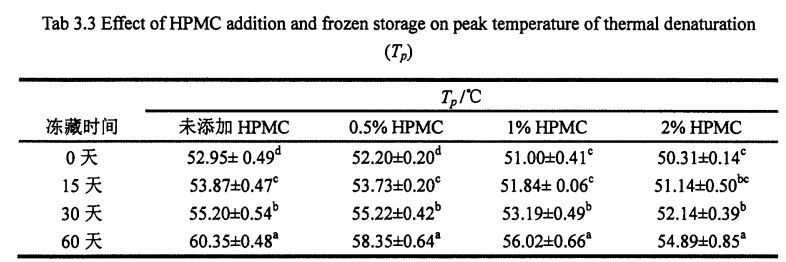
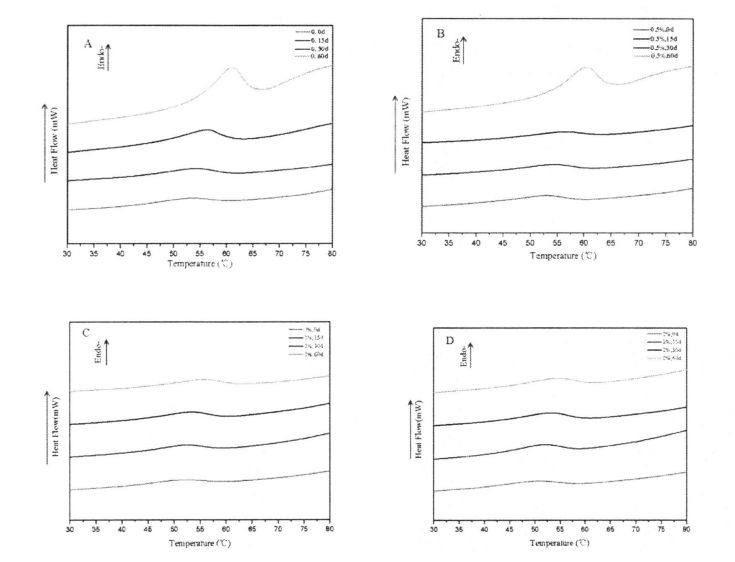
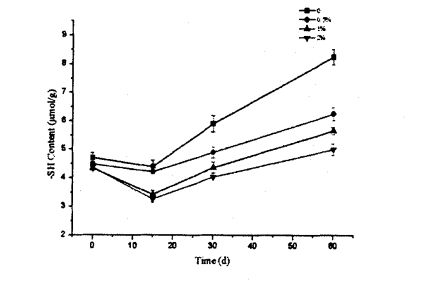
Fig 3.3 Effect of HPMC addition and frozen storage on the content of free-SH for gluten proteins As mentioned above, freezable water can form ice crystals at low temperatures and distribute in the interstices of the gluten network. Therefore, with the prolongation of freezing time, the ice crystals become larger, which squeezes the gluten protein structure more seriously, and leads to the breakage of some intermolecular and intramolecular disulfide bonds, which increases the content of free sulfhydryl groups. On the other hand, the experimental results show that HPMC can protect the disulfide bond from the extrusion damage of ice crystals, thereby inhibiting the depolymerization process of gluten protein. 3.3.4 Effects of HPMC addition amount and freezing storage time on transverse relaxation time (T2) of wet gluten mass The distribution of Transverse Relaxation Time (T2) can reflect the model and dynamic process of water migration in food materials [6]. Figure 3.4 shows the distribution of wet gluten mass at 0 and 60 days with different HPMC additions, including 4 main distribution intervals, namely 0.1.1 ms (T21), 1.10 ms (T22), 10.100 ms (dead;) and 1 00-1 000 ms (T24). Bosmans et al. (2012) found a similar distribution of wet gluten mass [1261], and they suggested that protons with relaxation times below 10 ms could be classified as rapidly relaxing protons, which are mainly derived from poor mobility the bound water, therefore, may characterize the relaxation time distribution of bound water bound to a small amount of starch, while Dang may characterize the relaxation time distribution of bound water bound to gluten protein. In addition, Kontogiorgos (2007) - t11¨, the "strands" of the gluten protein network structure are composed of several layers (Sheets) about 5 nm apart, and the water contained in these layers is limited water (or Bulk water, phase water), the mobility of this water is between the mobility of bound water and free water. ແລະ T23 ສາມາດໄດ້ຮັບການສະແດງໃຫ້ເຫັນເຖິງເວລາທີ່ຜ່ອນຄາຍການແຈກຈ່າຍນ້ໍາທີ່ຈໍາກັດ. The T24 distribution (>100 ms) has a long relaxation time, so it characterizes free water with strong mobility. ນ້ໍານີ້ມີຢູ່ໃນຮູຂຸມຂົນຂອງໂຄງສ້າງເຄືອຂ່າຍ, ແລະມີພຽງແຕ່ກໍາລັງທີ່ມີຄວາມອ່ອນແອກັບລະບົບທາດໂປຼຕີນຈາກທາດໂປຼຕີນຈາກ.
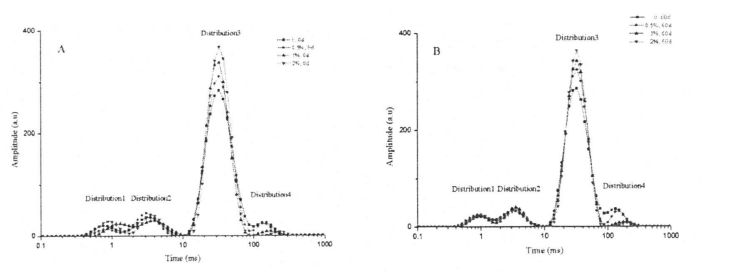
ຫມາຍເຫດ: A ແລະ B ເປັນຕົວແທນຂອງເວລາຜ່ອນຄາຍການຜ່ອນຄາຍ (n) ການແຈກຢາຍ gluten ທີ່ມີຄວາມຊຸ່ມແລະມີເນື້ອທີ່ແຕກຕ່າງກັນໃນເວລາ 0 ວັນແລະ 60 ວັນໃນການເກັບມ້ຽນອາກາດ
However, there were obvious differences in the height and area of T23 distribution of wet gluten mass that was not frozen and contained different HPMC additions, and with the increase of addition, the height and area of T23 distribution increased (Fig. 3.4). This change shows that HPMC can significantly increase the relative content of limited water, and it is positively correlated with the added amount within a certain range. In addition, with the extension of freezing storage time, the height and area of T23 distribution of the wet gluten mass with the same HPMC content decreased to varying degrees. Therefore, compared with bound water, limited water showed a certain effect on freezing storage. Sensitivity. This trend suggests that the interaction between the gluten protein matrix and the confined water becomes weaker. This may be because more hydrophobic groups are exposed during freezing, which is consistent with the thermal denaturation peak temperature measurements. ໂດຍສະເພາະ, ຄວາມສູງແລະພື້ນທີ່ຂອງ T23 ການແຈກຢາຍສໍາລັບມະຫາຊົນ gluten ທີ່ຊຸ່ມໂດຍມີ 2% HPMC ບໍ່ໄດ້ສະແດງຄວາມແຕກຕ່າງທີ່ສໍາຄັນ. This indicates that HPMC can limit the migration and redistribution of water, and can inhibit the transformation of the water state from the restricted state to the free state during the freezing process.
ໂດຍທົ່ວໄປແລ້ວການປາກເວົ້າ, ໂຄງປະກອບທາດໂປຼຕີນແບ່ງອອກເປັນ 4 ປະເພດ, α-spiral, β-β-β-β-conners ແລະ curns ແລະ curls ແບບສຸ່ມ. ພັນທະບັດມັດທະຍົມທີ່ສໍາຄັນທີ່ສຸດສໍາລັບການສ້າງຕັ້ງແລະສະຖຽນລະພາບຂອງຄວາມສອດຄ່ອງຂອງພື້ນທີ່ຂອງທາດໂປຼຕີນແມ່ນພັນທະບັດ hydrogen. Therefore, protein denaturation is a process of hydrogen bond breaking and conformational changes.
Fourier transform infrared spectroscopy (FT-IR) has been widely used for high-throughput determination of the secondary structure of protein samples. The characteristic bands in the infrared spectrum of proteins mainly include, amide I band (1700.1600 cm-1), amide II band (1600.1500 cm-1) and amide III band (1350.1200 cm-1). Correspondingly, the amide I band the absorption peak originates from the stretching vibration of the carbonyl group (-C=O-.), the amide II band is mainly due to the bending vibration of the amino group (-NH-) [1271], and the amide III band is mainly due to the amino bending vibration and .CN-.Synchronous compound vibration in the same plane of bond stretching vibration, and has a high sensitivity to changes in protein secondary structure [128'1291. ເຖິງແມ່ນວ່າວົງດົນຕີທີ່ມີລັກສະນະທີ່ສູງກວ່າສາມຢ່າງທີ່ມີລັກສະນະເດັ່ນຂອງໂປຣແກຣມໂປຣຕີນ, ແຕ່ມີຄວາມຖືກຕ້ອງຂອງ AMOWE WHOTIRITATION ຂອງໂຄງປະກອບ SEMI ໃນຂະນະທີ່ຈຸດສູງສຸດຂອງວົງດົນຕີທີ່ສູງສຸດ, ສະນັ້ນນັກຄົ້ນຄວ້າຫຼາຍຄົນໄດ້ວິເຄາະທາດໂປຼຕີນໃຫ້ແກ່ປະມານ 1640 ຊມ. 1 Wavenumber (ຊ້ອນກັນ), ເຊິ່ງຜົນກະທົບຕໍ່ຜົນກະທົບຕໍ່ຄວາມຖືກຕ້ອງຂອງຜົນໄດ້ຮັບ. ເພາະສະນັ້ນ, ການແຊກແຊງຂອງນ້ໍາຈໍາກັດການກໍານົດຂອງ Amide Imide I Band ໃນຄວາມຕັ້ງໃຈໂຄງສ້າງຂອງທາດໂປຼຕີນ. In this experiment, in order to avoid the interference of water, the relative contents of four secondary structures of gluten protein were obtained by analyzing the amide III band. ຕໍາແຫນ່ງສູງສຸດ (ໄລຍະຫ່າງຂອງ Waversumber) ຂອງ
Tab 3.4 ຕໍາແຫນ່ງແລະການມອບຫມາຍຂອງໂຄງສ້າງຮອງທີ່ມີມາຈາກວົງ A iIi Band ໃນ FT-IR SPECTRA

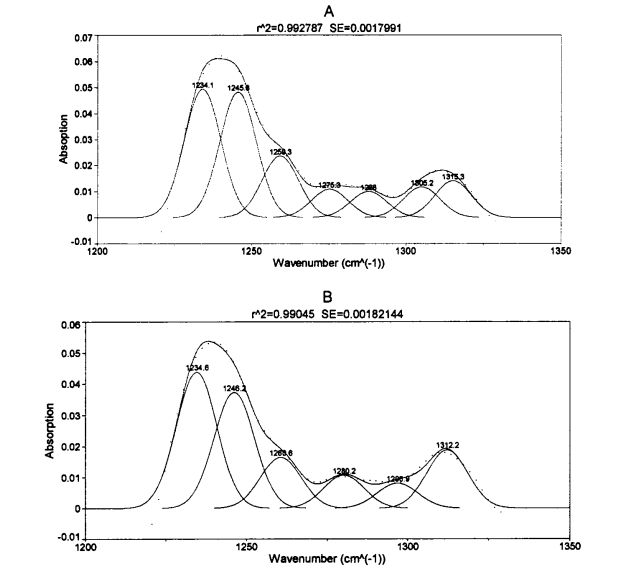
ຫມາຍເຫດ: A ແມ່ນລະດັບຄວາມປອດໄພຂອງທາດໂປຼຕີນຈາກເຂົ້າປ່າຂອງສາລີ Glar Gluten ໂດຍບໍ່ຕ້ອງເພີ່ມ HPMC ສໍາລັບການເກັບຮັກສາທີ່ແຂງ 0 ວັນ; b ແມ່ນສະພາບທີ່ມີທາດໂປຼຕີນຈາກເຂົ້າປ່າຂອງສາລີ Gluten ຂອງ Frozen Storage for 0 ວັນດ້ວຍ 2% HPMC ເພີ່ມ
ດ້ວຍການຍືດຍາວຂອງເວລາເກັບນ້ໍາແຂງ, ໂຄງສ້າງອັນດັບສອງຂອງໂປຣຕີນ Gluten ທີ່ມີການເພີ່ມເຕີມທີ່ແຕກຕ່າງກັນຂອງ HPMC ປ່ຽນເປັນລະດັບທີ່ແຕກຕ່າງກັນ. It can be seen that both frozen storage and addition of HPMC have an effect on the secondary structure of gluten protein. Regardless of the amount of HPMC added, B. The folded structure is the most dominant structure, accounting for about 60%. After 60 days of frozen storage, add 0%, OB Gluten of 5% and 1% HPMC. The relative content of folds increased significantly by 3.66%, 1.87% and 1.16%, respectively, which was similar to the results determined by Meziani et al. (2011) [l33J]. However, there was no significant difference during frozen storage for gluten supplemented with 2% HPMC. In addition, when frozen for 0 days, with the increase of HPMC addition, p. ເນື້ອໃນທີ່ກ່ຽວຂ້ອງຂອງພັບເພີ່ມຂື້ນເລັກນ້ອຍ, ໂດຍສະເພາະໃນເວລາທີ່ຈໍານວນເພີ່ມເຕີມແມ່ນ 2%, ຫນ້າ. ເນື້ອໃນທີ່ກ່ຽວຂ້ອງຂອງພັບເພີ່ມຂື້ນໂດຍ 2.01%. D. ໂຄງປະກອບທີ່ພັບສາມາດແບ່ງອອກເປັນ termolecular p. ພັບ (ເກີດມາຈາກການລວບລວມໂມເລກຸນທາດໂປຼຕີນ), antiparallel p. Folded and parallel p. ໂຄງສ້າງສາມໂຄງຮ່າງແມ່ນພັບ, ແລະມັນຍາກທີ່ຈະກໍານົດໂຄງການໃດທີ່ເກີດຂື້ນໃນລະຫວ່າງຂັ້ນຕອນການແຊ່ແຂງ
changed. Some researchers believe that the increase in the relative content of the B-type structure will lead to an increase in the rigidity and hydrophobicity of the steric conformation [41], and other researchers believe that p. ການເພີ່ມຂື້ນຂອງໂຄງສ້າງທີ່ພັບແມ່ນມາຈາກສ່ວນຫນຶ່ງຂອງການສ້າງຂື້ນໃຫມ່β-froman ແມ່ນປະກອບດ້ວຍຄວາມອ່ອນແອຂອງໂຄງສ້າງທີ່ຮັກສາໄວ້ໂດຍການຜູກມັດຂອງໄຮໂດຼລິກ [421]. β- The increase in the folded structure indicates that the protein is polymerized through hydrophobic bonds, which is consistent with the results of the peak temperature of thermal denaturation measured by DSC and the distribution of transverse relaxation time measured by low-field nuclear magnetic resonance. Protein denaturation. On the other hand, added 0.5%, 1% and 2% HPMC gluten protein α-whirling. The relative content of helix increased by 0.95%, 4.42% and 2.03% respectively with the prolongation of freezing time, which is consistent with Wang, et a1. (2014) found similar results [134]. 0 of gluten without added HPMC. There was no significant change in the relative content of helix during the frozen storage process, but with the increase of the addition amount of freeze for 0 days. There were significant differences in the relative content of α-whirling structures.
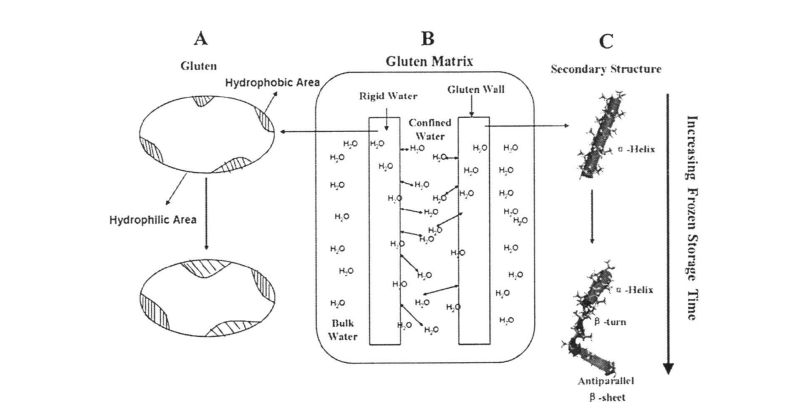
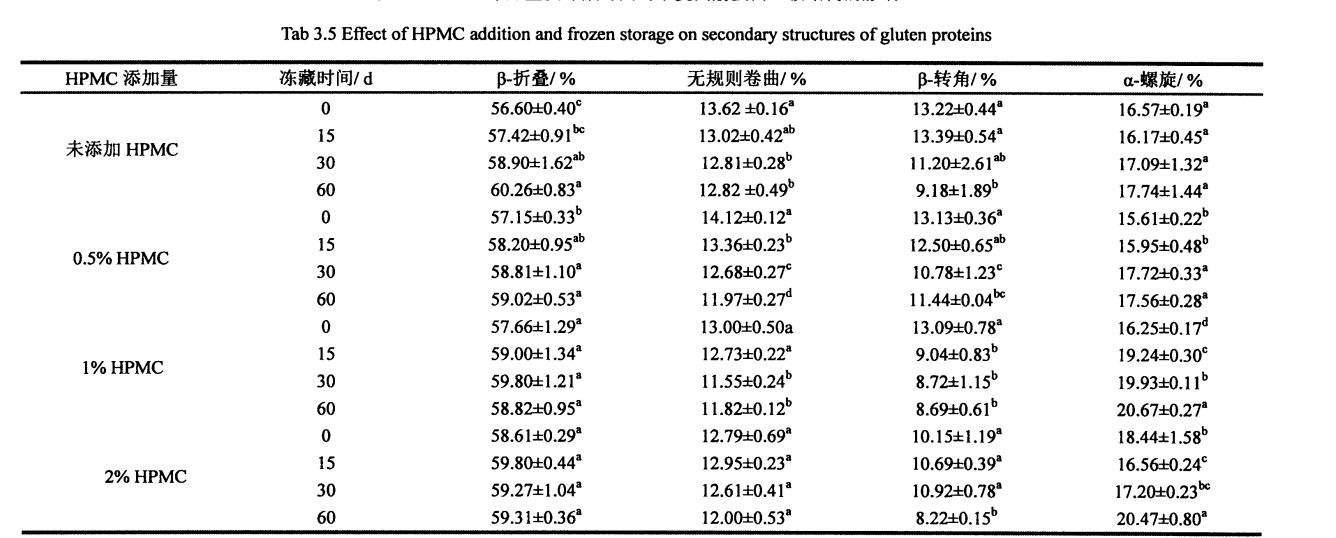
All samples with the extension of freezing time, p. The relative contents of the corners were significantly reduced. This shows that β-turn is very sensitive to freezing treatment [135. 1361], and whether HPMC is added or not has no effect. Wellner, et a1. (2005) proposed that the β-chain turn of gluten protein is related to the β-turn space domain structure of the glutenin polypeptide chain [l 37]. ເວັ້ນເສຍແຕ່ວ່າເນື້ອໃນຂອງເນື້ອໃນຂອງເນື້ອຫນັງທີ່ເພີ່ມຂື້ນຂອງທາດໂປຼຕີນຈາກ 2% ບໍ່ມີການປ່ຽນແປງທີ່ສໍາຄັນໃນການເກັບຮັກສາທີ່ມີຄວາມສໍາຄັນ, ຕົວຢ່າງອື່ນໆທີ່ຖືກຫຼຸດລົງຢ່າງຫຼວງຫຼາຍ, ເຊິ່ງອາດເກີດຈາກໄປເຊຍກັນກ້ອນ. ນອກຈາກນັ້ນ, ໃນເວລາທີ່ແຊ່ແຂງໃນເວລາ 0 ວັນ, ໂຄງປະກອບທີ່ກ່ຽວຂ້ອງກັບທາດໂປຼຕີນຈາກ 2% ແລະβ-Sheet This may indicate that there is an interaction between HPMC and gluten protein, forming new hydrogen bonds and then affecting the conformation of the protein; or HPMC absorbs the water in the pore cavity of the protein space structure, which deforms the protein and leads to more changes between the subunits. close. The increase of the relative content of β-sheet structure and the decrease of the relative content of β-turn and α-helix structure are consistent with the above speculation. During the freezing process, the diffusion and migration of water and the formation of ice crystals destroy the hydrogen bonds that maintain the conformational stability and expose the hydrophobic groups of proteins. In addition, from the perspective of energy, the smaller the energy of the protein, the more stable it is. At low temperature, the self-organization behavior (folding and unfolding) of protein molecules proceeds spontaneously and leads to conformational changes.
3.3.6 ຜົນກະທົບຂອງຈໍານວນການເພີ່ມເຕີມຂອງ HPMC
ໂມເລກຸນໂປຣຕີນປະກອບມີທັງສອງກຸ່ມ hydrophilic ແລະ hydrophobic. Generally, the protein surface is composed of hydrophilic groups, which can bind water through hydrogen bonding to form a hydration layer to prevent protein molecules from agglomerating and maintain their conformational stability. The interior of the protein contains more hydrophobic groups to form and maintain the secondary and tertiary structure of the protein through the hydrophobic force. Denaturation of proteins is often accompanied by exposure of hydrophobic groups and increased surface hydrophobicity.

ຫມາຍເຫດ: ຢູ່ໃນແຖວດຽວກັນ, ມີຈົດຫມາຍສະບັບດີທີ່ບໍ່ມີ m ແລະ b, ສະແດງໃຫ້ເຫັນວ່າມີຄວາມແຕກຕ່າງທີ່ສໍາຄັນ (<0.05);
After 60 days of frozen storage, add 0%, O. The surface hydrophobicity of gluten with 5%, 1% and 2% HPMC increased by 70.53%, 55.63%, 43.97% and 36.69%, respectively (Table 3.6). ໂດຍສະເພາະ, Surfen Hydrophobicity of the gluten Protin ໂດຍບໍ່ຕ້ອງເພີ່ມປະມານ 30 ວັນ ໃນເວລາດຽວກັນ, ຫຼັງຈາກ 60 ວັນຂອງການເກັບຮັກສາອາກາດຫນາວ, ນ້ໍາສ້າງດ້ານຂອງທາດໂປຼຕີນຈາກ gluten ເພີ່ມດ້ວຍຄວາມແຕກຕ່າງທີ່ແຕກຕ່າງກັນ. However, after 60 days of frozen storage, the surface hydrophobicity of gluten protein added with 2% HPMC only increased from 19.749 to 26.995, which was not significantly different from the surface hydrophobicity value after 30 days of frozen storage, and was always lower than other the value of the surface hydrophobicity of the sample. ນີ້ສະແດງໃຫ້ເຫັນວ່າ HPMC ສາມາດຍັບຍັ້ງການປະຕິເສດທາດໂປຼຕີນຈາກ glatht, ເຊິ່ງສອດຄ່ອງກັບຜົນຂອງການກໍານົດຂອງອຸນຫະພູມ dsc ຂອງສູງສຸດຂອງການຜິດປົກກະຕິຄວາມຮ້ອນ. This is because HPMC can inhibit the destruction of protein structure by recrystallization, and due to its hydrophilicity,
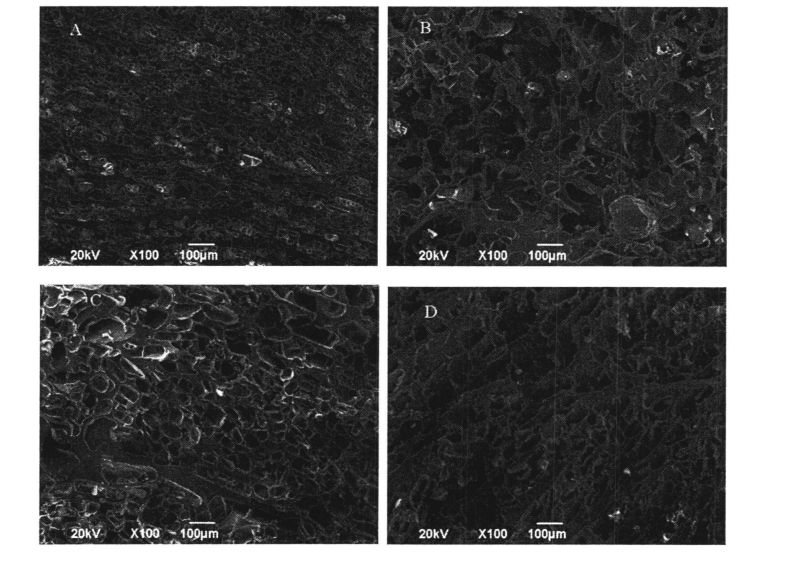
3.4 ບົດສະຫຼຸບ
This experiment investigated the rheology of wet gluten dough and gluten protein by adding HPMC with different contents (0%, 0.5%, 1% and 2%) during freezing storage (0, 15, 30 and 60 days). properties, thermodynamic properties, and effects of physicochemical properties. The study found that the change and redistribution of water state during the freezing storage process significantly increased the freezable water content in the wet gluten system, which led to the destruction of the gluten structure due to the formation and growth of ice crystals, and ultimately caused the processing properties of the dough to be different. Deterioration of product quality. The results of frequency scanning showed that the elastic modulus and viscous modulus of the wet gluten mass without adding HPMC decreased significantly during the freezing storage process, and the scanning electron microscope showed that its microstructure was damaged. ເນື້ອໃນຂອງກຸ່ມ aclhydryl ຟຣີໄດ້ຮັບການເພີ່ມຂື້ນຢ່າງຫຼວງຫຼາຍ, ແລະກຸ່ມ hydrophobic ຂອງມັນໄດ້ຖືກເປີດເຜີຍຫຼາຍ, ເຊິ່ງເຮັດໃຫ້ອຸນຫະພູມ denaturation ຄວາມຮ້ອນແລະຄວາມຮ້ອນດ້ານຂອງທາດໂປຼຕີນຈາກຜິວເນື້ອສີ gluten ເພີ່ມຂື້ນຢ່າງຫຼວງຫຼາຍ. However, the experimental results show that the addition of I-IPMC can effectively inhibit the changes in the structure and properties of wet gluten mass and gluten protein during freezing storage, and within a certain range, this inhibitory effect is positively correlated with the addition of HPMC. This is because HPMC can reduce the mobility of water and limit the increase of the freezable water content, thereby inhibiting the recrystallization phenomenon and keeping the gluten network structure and the spatial conformation of the protein relatively stable. This shows that the addition of HPMC can effectively maintain the integrity of the frozen dough structure, thereby ensuring product quality.
4.1 ພາກສະເຫນີ
Starch is a chain polysaccharide with glucose as the monomer. key) two types. From a microscopic point of view, starch is usually granular, and the particle size of wheat starch is mainly distributed in two ranges of 2-10 pro (B starch) and 25-35 pm (A starch). ຈາກທັດສະນະຂອງໂຄງສ້າງຂອງໂຄງສ້າງຜລຶກ, ພື້ນທີ່ຂອງນ້ໍາມັນເຊື້ອໄຟແລະປະເພດທີ່ບໍ່ແມ່ນຜລຶກ) Generally, the crystalline region consists of amylopectin and the amorphous region consists mainly of amylose. ນີ້ແມ່ນຍ້ອນວ່າ, ນອກເຫນືອໄປຈາກຕ່ອງໂສ້ C (ລະບົບຕ່ອງໂສ້ຕົ້ນຕໍ), ລະບົບຕ່ອງໂສ້ຕົ້ນຕໍກໍ່ມີຕ່ອງໂສ້ດ້ານຂ້າງຂອງ b (CHOWN CHOWN) The shape of the crystallite bundle is arranged in a certain way to form a crystal.
Among them, starch gelatinization refers to the process in which starch granules are gradually disintegrated and hydrated in a system with high water content and under heating conditions. It can be roughly divided into three main processes. 1) Reversible water absorption stage; before reaching the initial temperature of gelatinization, the starch granules in the starch suspension (Slurry) keep their unique structure unchanged, and the external shape and internal structure basically do not change. Only very little soluble starch is dispersed in the water and can be restored to its original state. 2) The irreversible water absorption stage; as the temperature increases, water enters the gap between the starch crystallite bundles, irreversibly absorbs a large amount of water, causing the starch to swell, the volume expands several times, and the hydrogen bonds between the starch molecules are broken. It becomes stretched and the crystals disappear. At the same time, the birefringence phenomenon of starch, that is, the Maltese Cross observed under a polarizing microscope, begins to disappear, and the temperature at this time is called the initial gelatinization temperature of starch. 3) Starch granule disintegration stage; ໂມເລກຸນໂມເລກຸນປະມານເຂົ້າໃນລະບົບການແກ້ໄຂບັນຈຸທາດແປ້ງ (PLARCH PHENIONS, ແລະອຸນຫະພູມທີ່ໃຫຍ່ທີ່ສຸດ, ແລະມີຄວາມເປັນຈິງທີ່ມີຄວາມຍືດຍຸ່ນ ໃນເວລາທີ່ dough ໄດ້ຖືກປຸງແຕ່ງ, gelatinization ຂອງທາດແປ້ງໄດ້ endows ອາຫານທີ່ມີໂຄງສ້າງທີ່ເປັນເອກະລັກ, ມີລົດຊາດ, ລົດຊາດ, ສີແລະຄຸນລັກສະນະຂອງມັນ.
In general, starch gelatinization is affected by the source and type of starch, the relative content of amylose and amylopectin in starch, whether starch is modified and the method of modification, addition of other exogenous substances, and dispersion conditions (such as The influence of salt ion species and concentration, pH value, temperature, moisture content, etc.) [142-150]. ເພາະສະນັ້ນ, ໃນເວລາທີ່ໂຄງສ້າງຂອງທາດແປ້ງ (ປະຊາຊົນໃນພື້ນຜິວ, ໂຄງສ້າງຜົ້ງສາລີ, ຄຸນສົມບັດຕ່າງໆ, ຄຸນສົມບັດຕ່າງໆ, ການຍ່ອຍອາຫານ, ທາດແປ້ງຈະໄດ້ຮັບຜົນກະທົບ.
4.2.2 ເຄື່ອງໃຊ້ທົດລອງ
ອາບນໍ້າຄົງທີ່ຢູ່ໃນອຸນຫະພູມດີຈີຕອນດິຈິຕອນ
ຕູ້ເຢັນ BCD-2010 AMILLT
ເຕົາໄຟ Sx2.4.10 Muffle
DHG. 9070A Blast Drying Oven
Discovery R3 Ridation Ridation Ridation
ຄໍາຖາມທີ 200 calonning scannial ທີ່ແຕກຕ່າງກັນ
ເຕົາໄຟ Sx2.4.10 Muffle
ຜູ້ຜະລິດ
ບໍລິສັດ Meils HEFEI, ຈໍາກັດ.
ບໍລິສັດອາເມລິກາ
ບໍລິສັດອາເມລິກາ
4.2.3 ວິທີການທົດລອງ
4.2.3.1 ການກະກຽມແລະການເກັບຮັກສາຄວາມຊຸ່ມຊື່ນ
4.2.3.2 ຄຸນລັກສະນະຂອງສັນຍາທິບ
ໃນການທົດລອງນີ້, Rheometer ໄດ້ຖືກນໍາໃຊ້ແທນທີ່ຈະວັດແທກຄວາມຫມາຍທີ່ມີຄຸນລັກສະນະຂອງທາດແປ້ງ gelatinization. ເບິ່ງ bae et a1. (2014) ວິທີການ [1571] ມີການດັດແປງເລັກນ້ອຍ. The specific program parameters are set as follows: use a plate with a diameter of 40 mill, the gap (gap) is 1000 mm, and the rotation speed is 5 rad/s; I) incubate at 50 °C for 1 min; ii) at 5. C/min heated to 95°C; iii) kept at 95°C for 2.5 min, iv) then cooled to 50°C at 5°C/min; v) lastly held at 50°C for 5 min.
Draw 1.5 mL of sample solution and add it to the center of the rheometer sample stage, measure the gelatinization properties of the sample according to the above program parameters, and obtain the time (min) as the abscissa, the viscosity (Pa s) and the temperature (°C) as the starch gelatinization curve of the ordinate. ອີງຕາມການຂອງ GB / T 14490.2008 [158], ອຸນຫະພູມສູງສຸດຂອງ Gelatinization-Gelatinization-Viscosity (ສູງສຸດ), ມູນຄ່າການເສື່ອມໂຊມ (ການເສື່ອມໂຊມ) ແມ່ນໄດ້ຮັບ. Value, BV) and regeneration value (Setback Value, SV), wherein, decay value = peak viscosity - minimum viscosity; setback value = final viscosity - minimum viscosity. Each sample was repeated three times.
Take 2.5 g of amyloid and mix it with distilled water in a ratio of 1:2 to make starch milk. Freeze ທີ່ 18 ° C ສໍາລັບ 15 D, 30 D, ແລະ 60 d. Add 0.5, 1, 2% HPMC (w/w) to replace starch of the same quality, and other preparation methods remain unchanged. After the freezing treatment is completed, take it out, equilibrate at 4 °C for 4 h, and then thaw at room temperature until it is tested.
(3) ຄວາມເຂັ້ມແຂງຂອງທາດແປ້ງ (ຄວາມເຂັ້ມແຂງຂອງເຈນ)
ຫຼັງຈາກນັ້ນ, ກວາດຄວາມຖີ່ຂອງການ oscillation, ກໍານົດຈໍານວນສາຍພັນ (ສາຍພັນ) ເຖິງ 0.1% (ອີງຕາມຜົນໄດ້ຮັບຂອງຄວາມອິດເມື່ອຍ), ແລະຕັ້ງຄ່າຄວາມຖີ່ 1 ຫາ 10 hz. Each sample was repeated three times.
4.2.3.4 ຄຸນສົມບັດຂອງ thermodynamic
ການເອົາຜ້າປູທີ່ເປັນພື້ນທີ່ຫວ່າງເປັນເອກະສານອ້າງອີງ, ອັດຕາການໄຫລຂອງໄນໂຕຣເຈນແມ່ນ 50 ມລ, ການສົມທຽບໃນເວລາ 5 ນາທີ, ແລະຫຼັງຈາກນັ້ນໃຫ້ຮ້ອນເຖິງ 100 ° C ທີ່ 5 ° C / MIN C / MIN C / MIN. Finally, the heat flow (Heat Flow, mW) is the DSC curve of the ordinate, and the gelatinization peak was integrated and analyzed by Universal Analysis 2000. Each sample was repeated at least three times.
Take 0.1 g of the dried, ground and sieved amyloid into a 50 mL centrifuge tube, add 10 mL of distilled water to it, shake it well, let it stand for 0.5 h, and then place it in a 95°C water bath at a constant temperature. After 30 min, after gelatinization is complete, take out the centrifuge tube and place it in an ice bath for 10 min for rapid cooling. Finally, centrifuge at 5000 rpm for 20 min, and pour off the supernatant to obtain a precipitate. ພະລັງງານທີ່ມີອາການໃຄ່ບວມ = ສານຝົນຕົກ / ມວນຕົວຢ່າງ [163].
ການທົດລອງທັງຫມົດໄດ້ຖືກເຮັດຊ້ໍາຢ່າງຫນ້ອຍສາມຄັ້ງເວັ້ນເສຍແຕ່ໄດ້ລະບຸໄວ້ໃນລະດັບອື່ນ, ແລະຜົນໄດ້ຮັບໃນການທົດລອງໄດ້ຖືກສະແດງອອກເປັນຄວາມຫມາຍແລະການບ່ຽງເບນມາດຕະຖານ. SPSS Statistic 19 was used for analysis of variance (Analysis of Variance, ANOVA) with a significance level of 0.05; correlation charts were drawn using Origin 8.0.
According to GB 50093.2010, GB/T 5009.9.2008, GB 50094.2010 (78-s0), the basic components of wheat starch - moisture, amylose/amylopectin and ash content were determined. ຜົນໄດ້ຮັບແມ່ນສະແດງຢູ່ໃນຕາຕະລາງ 4. 1 ສະແດງໃຫ້ເຫັນ.
ແຕະ 4.1 ເນື້ອໃນຂອງສ່ວນປະກອບຂອງທາດແປ້ງເຂົ້າສາລີ

ທາດແປ້ງທີ່ໂຈະດ້ວຍຄວາມເຂັ້ມຂົ້ນທີ່ແນ່ນອນແມ່ນມີຄວາມຮ້ອນໃນອັດຕາຄວາມຮ້ອນທີ່ແນ່ນອນເພື່ອເຮັດໃຫ້ທາດແປ້ງ gelatinized. After starting to gelatinize, the turbid liquid gradually becomes pasty due to the expansion of starch, and the viscosity increases continuously. ຕໍ່ມາ, ທາດແປ້ງ richal ແລະ vscomesity ຫຼຸດລົງ. ໃນເວລາທີ່ paste ໄດ້ເຢັນລົງໃນອັດຕາຄວາມເຢັນທີ່ແນ່ນອນ, paste ຈະ gel, ແລະມູນຄ່າ viscosity ຈະເພີ່ມຂື້ນຕື່ມ. ມູນຄ່າ viscosity ໃນເວລາທີ່ມັນເຢັນລົງເຖິງ 50 ° C ແມ່ນມູນຄ່າ viscosity ສຸດທ້າຍ (ຮູບ 4.1).
Table 4.2 lists the influence of several important indicators of starch gelatinization characteristics, including gelatinization peak viscosity, minimum viscosity, final viscosity, decay value and appreciation value, and reflects the effect of HPMC addition and freezing time on starch paste. effects of chemical properties. The experimental results show that the peak viscosity, the minimum viscosity and the final viscosity of starch without frozen storage increased significantly with the increase of HPMC addition, while the decay value and recovery value decreased significantly. Specifically, the peak viscosity gradually increased from 727.66+90.70 CP (without adding HPMC) to 758.51+48.12 CP (adding 0.5% HPMC), 809.754-56.59 CP (adding 1 %HPMC), and 946.64+9.63 CP (adding 2% HPMC); ຄວາມທຸກທໍລະມານຕ່ໍາສຸດໄດ້ເພີ່ມຂື້ນຈາກ 391.02 + 18.97 CP (ບໍ່ຕ້ອງເພີ່ມ) ເຖິງ 454.03.0.0.5) ແລະ 553.03 + 55.57 + ຕື່ມ 2% hpmc); viscosity ສຸດທ້າຍແມ່ນມາຈາກ 794.62.412.84 CP (ໂດຍບໍ່ຕ້ອງເພີ່ມ HPMC) ເພີ່ມຂື້ນ 0.5.64.64 -18.88.04.54-34.57 CP (ເພີ່ມ 2% hpmc); ເຖິງຢ່າງໃດກໍ່ຕາມ, ມູນຄ່າການປະຕິເສດລະດັບຄ່ອຍໆຈາກ 336.644-71.71 CP (ໂດຍບໍ່ຕ້ອງເພີ່ມ HPMC) ເຖິງ 303,5% hpmc), 324.19 ± 2.54 CP (ເພີ່ມເຕີມ
ກັບ 1% HPMC) ແລະ 393.614-45.94 CP (ມີ 1%) 357.85+21.00 CP (2% HPMC added). ນີ້ແລະການເພີ່ມ hydrocolloids ເຊັ່ນ: xanthan gum ແລະ suphanthakakan & suphantharika (2008) ສາມາດເພີ່ມຄວາມຮັກຂອງທາດແປ້ງ gelatinization ໃນຂະນະທີ່ຫຼຸດຜ່ອນມູນຄ່າທາດແປ້ງ. This may be mainly because HPMC acts as a kind of hydrophilic colloid, and the addition of HPMC increases the gelatinization peak viscosity due to the hydrophilic group on its side chain which makes it more hydrophilic than starch granules at room temperature. In addition, the temperature range of the thermal gelatinization process (thermogelation process) of HPMC is larger than that of starch (results not shown), so that the addition of HPMC can effectively suppress the drastic decrease in viscosity due to the disintegration of starch granules. Therefore, the minimum viscosity and final viscosity of starch gelatinization increased gradually with the increase of HPMC content.

The final viscosity of starch suspension without adding HPMC increased from 794.62 ± 12.84 CP (frozen storage for 0 days) to 1413.15 ± 45.59 CP (frozen storage for 60 days). The peak viscosity of starch suspension increased from 882.24 ± 22.40 CP (frozen storage for 0 days) to 1322.86 ± 36.23 CP (frozen storage for 60 days); the peak viscosity of starch suspension added with 1% HPMC The viscosity increased from 846.04 ± 12.66 CP (frozen storage 0 days) to 1291.94 ± 88.57 CP (frozen storage for 60 days); ແລະ viscosity peak gelatinization ຂອງ suspenions ຂອງ peak ມີ 2% hpmc ເພີ່ມຂື້ນຈາກ 91 0.88 ± 34.57 CP
ມັນສາມາດເຫັນໄດ້ວ່າດ້ວຍເວລາການເກັບຮັກສາທີ່ຫນາວເຢັນ, ດັດຊະນີຄຸນລັກສະນະຂອງແປ້ງ f2015) 1. Consistent with the experimental results, they found that with the increase of the number of freeze-thaw cycles, the peak viscosity, minimum viscosity, final viscosity, decay value, and retrogradation value of starch gelatinization all increased to different degrees [166J]. ພາກພື້ນທີ່ມີຄວາມສຸກ (ໃນພາກພື້ນ Amorphous) ໃນເຂດ Amorphous) gelatinization, and an increase in the related attenuation value and retrogradation value. However, the addition of HPMC inhibited the effect of ice crystallization on starch structure. Therefore, the peak viscosity, minimum viscosity, final viscosity, decay value and retrogradation rate of starch gelatinization increased with the addition of HPMC during frozen storage. increase and decrease sequentially.


ຕົວເລກ 4.2 ຂັ້ນຂອງການວາງຂອງທາດແປ້ງໂດຍບໍ່ມີ hpmC (A) ຫຼືກັບ 2% HPMC (B)

(Thixotropic Loop) area, which is similar to Temsiripong, et a1. (2005) ລາຍງານສະຫຼຸບດຽວກັນ [167]. This may be mainly because HPMC can form intermolecular cross-links with gelatinized starch chains (mainly amylose chains), which "bound" the separation of amylose and amylopectin under the action of shearing force. , ເພື່ອຮັກສາຄວາມຫມັ້ນຄົງຂອງພີ່ນ້ອງແລະຄວາມເປັນເອກະພາບຂອງໂຄງສ້າງ
However, with the prolongation of freezing storage time, the values of K and n increased to different degrees, among which the value of K increased from 78.240 ± 1.661 Pa·sn (unadded, 0 days) to 95.570 ± 1, respectively. 2.421 Pa·sn (no addition, 60 days), increased from 65.683±1.035 Pa ·S n (addition of O. 5% HPMC, 0 days) to 51.384±1.350 Pa ·S n (Add to 0.5% HPMC, 60 days), increased from 43.122±1.047 Pa ·sn (adding 1% HPMC, 0 days) to 56.538 ± 1.378 P an (ເພີ່ມ 1% HPMC, 0 ວັນ) ເຖິງ 16.064 ± 0.465 ± 0.465 ± 0.465.000 P ± 0.011 ± 0.011 (ໂດຍບໍ່ຕ້ອງເພີ່ມ HPMC, 0 ວັນ) ເພີ່ມຂື້ນ 0.01 ± 0.01 ± 0.013 (ຕື່ມ 1% hpmc, 0 ວັນ) ເຖິງ 0.340 ± 0.013 (add 1% HPMC, 60 days), and from 0.431 ± 0.013 (add 1% HPMC, 60 days) 2% HPMC, 0 days) to 0.404+0.020 (add 2% HPMC, 60 days). ໂດຍການປຽບທຽບ, ມັນສາມາດພົບໄດ້ວ່າການເພີ່ມຂື້ນຂອງຈໍານວນເງິນ HPMC, ເຊິ່ງຈະເຮັດໃຫ້ການເພີ່ມຂອງ HPMC ສາມາດເຮັດໃຫ້ມີທາດແປ້ງທີ່ຫມັ້ນຄົງພາຍໃຕ້ການວັດແທກຜົນຂອງການວັດແທກຄຸນລັກສະນະຂອງທາດແປ້ງ. ສອດຄ່ອງ.

Note: A is the change of viscoelasticity of unadded HPMC starch with the extension of freezing storage time; B is the addition of O. The change of viscoelasticity of 5% HPMC starch with the extension of freezing storage time; C ແມ່ນການປ່ຽນແປງຂອງ viscoelasticity ຂອງ 1% ທາດແປ້ງ hpmc ດ້ວຍການຂະຫຍາຍເວລາເກັບຮັກສາທີ່ຫນາວເຢັນ; D is the change of the viscoelasticity of 2% HPMC starch with the extension of freezing storage time
The swelling ratio of starch can reflect the size of starch gelatinization and water swelling, and the stability of starch paste under centrifugal conditions. As shown in Figure 4.4, for starch without frozen storage, with the increase of HPMC addition, the swelling force of starch increased from 8.969+0.099 (without adding HPMC) to 9.282- -L0.069 (adding 2% HPMC), which shows that the addition of HPMC increases the swelling water absorption and makes starch more stable after gelatinization, which is consistent with the conclusion of starch gelatinization characteristics. However, with the extension of frozen storage time, the swelling power of starch decreased. Compared with 0 days of frozen storage, the swelling power of starch decreased from 8.969-a:0.099 to 7.057+0 after frozen storage for 60 days, respectively. .007 (ບໍ່ມີ HPMC ເພີ່ມຫຍັງເລີຍ) ຜົນໄດ້ຮັບດັ່ງກ່າວໄດ້ສະແດງໃຫ້ເຫັນວ່າເມັດຂອງທາດແປ້ງໄດ້ຮັບຄວາມເສຍຫາຍຫຼັງຈາກບ່ອນເກັບມ້ຽນທີ່ບໍ່ລອຍ, ເຮັດໃຫ້ນ້ໍາຝົນຂອງສ່ວນນ້ໍາມັນເປື້ອນແລະມີຄວາມສຸກ. Therefore, the solubility of starch increased and the swelling power decreased. In addition, after freezing storage, starch gelatinized starch paste, its stability and water holding capacity decreased, and the combined action of the two reduced the swelling power of starch [1711]. On the other hand, with the increase of HPMC addition, the decline of starch swelling power gradually decreased, indicating that HPMC can reduce the amount of damaged starch formed during freezing storage and inhibit the degree of starch granule damage.
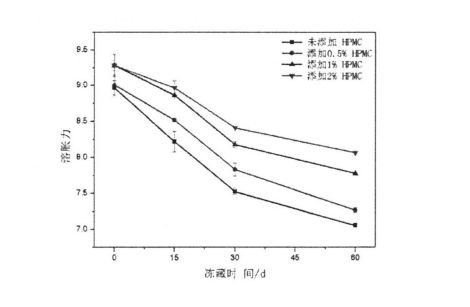
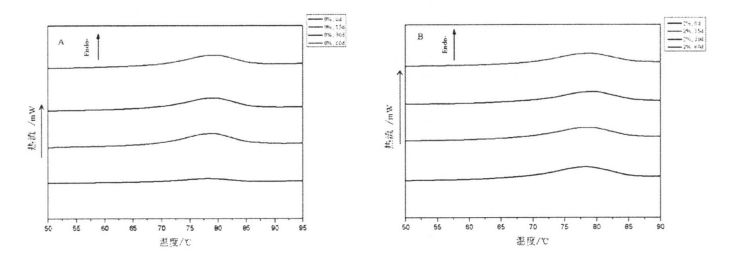
ຫມາຍເຫດ: A ແມ່ນ DSC CURL CUSCHE ໂດຍບໍ່ຕ້ອງໃສ່ hpmc ແລະ Frozen ສໍາລັບ 0,1, 15, 15% ສໍາລັບ 0,5, 15, 30 ແລະ 60 ວັນ
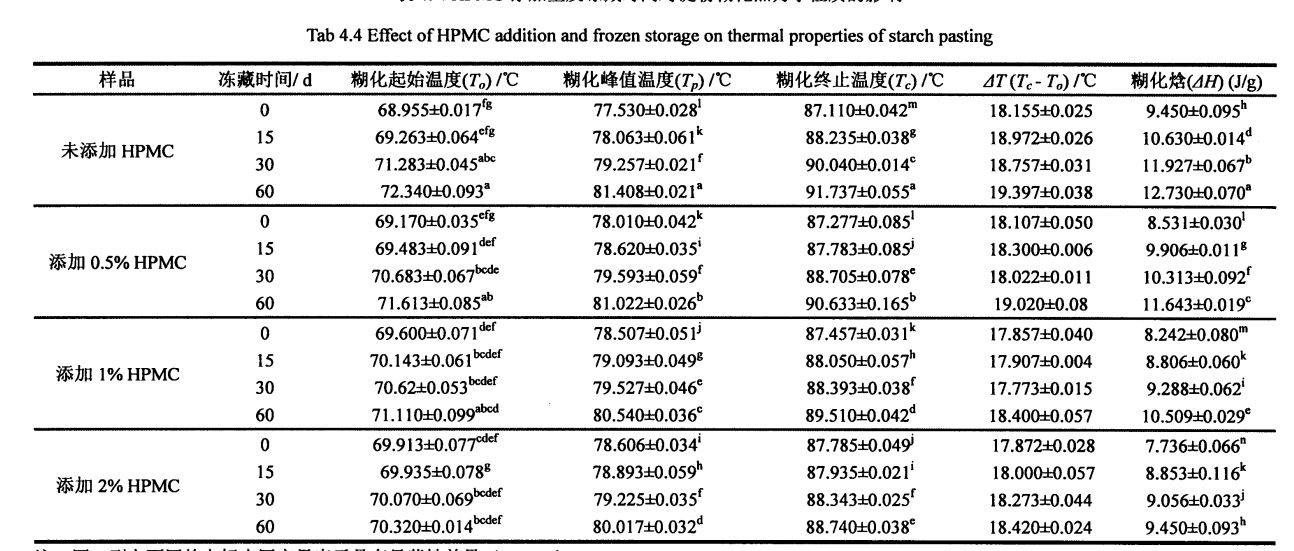
As shown in Table 4.4, for fresh amyloid, with the increase of HPMC addition, starch L has no significant difference, but increases significantly, from 77.530 ± 0.028 (without adding HPMC) to 78.010 ± 0.042 (add 0.5% HPMC), 78.507 ± 0.051 (add 1% HPMC), and 78.606 ± 0.034 (add 2% HPMC), but 4H is significant Decrease, from 9.450 ± 0.095 (without adding HPMC) to 8.53 ± 0.030 (adding 0.5% HPMC), 8.242A: 0.080 (adding 1% HPMC) and 7 .736 ± 0.066 (add 2% HPMC). This is similar to Zhou, et a1. (2008) ພົບວ່າການເພີ່ມ colloid hydrophilic ຫຼຸດລົງຂອງແປ້ງເຂົ້າຫນົມປັງແລະເພີ່ມຂຶ້ນຂອງອຸນຫະພູມສູງສຸດຂອງ pelatinization ທີ່ມີທາດແປ້ງ [172]. This is mainly because HPMC has better hydrophilicity and is easier to combine with water than starch. ໃນເວລາດຽວກັນ, ເນື່ອງຈາກວ່າລະດັບອຸນຫະພູມຂະຫນາດໃຫຍ່ຂອງຂະບວນການ gelatination ຂອງ HPMC, ໃນຂະນະທີ່ enthalty enthalpy ຫຼຸດລົງ.
On the other hand, starch gelatinization To, T p, Tc, △T and △Hall increased with the extension of freezing time. Specifically, starch gelatinization with 1% or 2% HPMC added had no significant difference after freezing for 60 days, while starch without or with 0.5% HPMC was added from 68.955±0.01 7 (frozen storage for 0 days) increased to 72.340 ± 0.093 (frozen storage for 60 days), and from 69.170 ± 0.035 (frozen storage for 0 days) to 71.613 ± 0.085 (ການເກັບຮັກສາທີ່ແຂງໃນເວລາ 0 ວັນ) 60 ວັນ); after 60 days of frozen storage, the growth rate of starch gelatinization decreased with the increase of HPMC addition, such as starch without HPMC added from 77.530 ± 0.028 (frozen storage for 0 days) to 81.028. 408 ± 0.021 (frozen storage for 60 days), while the starch added with 2% HPMC increased from 78.606 ± 0.034 (frozen storage for 0 days) to 80.017 ± 0.032 (frozen storage for 60 days). days); in addition, ΔH also showed the same change rule, which increased from 9.450 ± 0.095 (no addition, 0 days) to 12.730 ± 0.070 (no addition, 60 days), respectively, from 8.450 ± 0.095 (no addition, 0 days) to 12.730 ± 0.070 (no addition, 60 days), respectively. 531 ± 0.030 (add 0.5%, 0 days) to 11.643 ± 0.019 (add 0.5%, 60 days), from 8.242 ± 0.080 (add 1%, 0 days) to 10.509 ± 0.029 (add 1%, 60 days), and from 7.736 ± O. 066 (2% addition, 0 days) rose to 9.450 ± 0.093 (2% addition, 60 days). The main reasons for the above-mentioned changes in the thermodynamic properties of starch gelatinization during the frozen storage process are the formation of damaged starch, which destroys the amorphous region (amorphous region) and increases the crystallinity of the crystalline region. The coexistence of the two increases the relative crystallinity of starch, which in turn leads to an increase in thermodynamic indexes such as starch gelatinization peak temperature and gelatinization enthalpy. However, through comparison, it can be found that under the same freezing storage time, with the increase of HPMC addition, the increase of starch gelatinization To, T p, Tc, ΔT and ΔH gradually decreases. It can be seen that the addition of HPMC can effectively maintain the relative stability of the starch crystal structure, thereby inhibiting the increase of the thermodynamic properties of starch gelatinization.
Figure 4.6. As shown in A, the positions of the starch crystallization peaks are located at 170, 180, 190 and 230, respectively, and there is no significant change in the peak positions regardless of whether they are treated by freezing or adding HPMC. ນີ້ສະແດງໃຫ້ເຫັນວ່າ, ໃນຖານະເປັນຄຸນສົມບັດທີ່ແທ້ຈິງຂອງ hello ຂອງ helloalling, ຮູບແບບ Crystalline ຍັງຄົງຄົງທີ່.
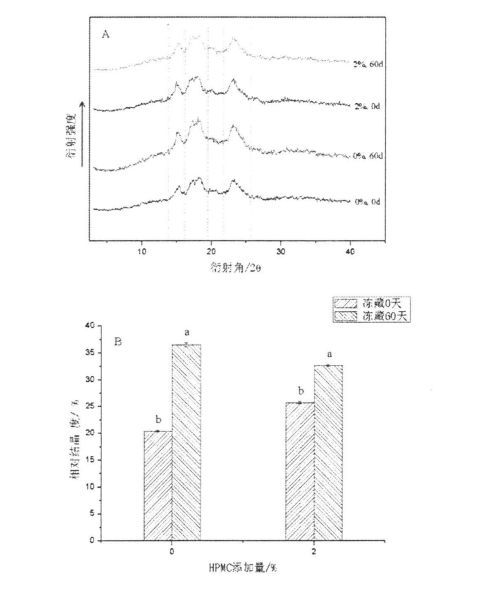
Starch is the most abundant dry matter in dough, which, after gelatinization, adds unique qualities (specific volume, texture, sensory, flavor, etc.) to the dough product. Since the change of starch structure will affect its gelatinization characteristics, which will also affect the quality of flour products, in this experiment, the gelatinization characteristics, flowability and flowability of starch after frozen storage were investigated by examining starch suspensions with different contents of HPMC added. ການປ່ຽນແປງຂອງຄຸນລັກສະນະຂອງພະລັງງານ, ຄຸນລັກສະນະຂອງຄວາມຮ້ອນແລະໂຄງສ້າງຂອງຜລຶກ The experimental results showed that after 60 days of frozen storage, the starch gelatinization characteristics (peak viscosity, minimum viscosity, final viscosity, decay value and retrogradation value) all increased due to the significant increase in the relative crystallinity of starch and the increase in the content of damaged starch. The gelatinization enthalpy increased, while the gel strength of starch paste decreased significantly; ເຖິງຢ່າງໃດກໍ່ຕາມ, ໂດຍສະເພາະແມ່ນການຍົກແປງຂອງທາດແປ້ງທີ່ເພີ່ມຂື້ນ 2%, ຄວາມເຂັ້ມແຂງຂອງ HPMC ຫຼຸດລົງໃນລະດັບຂອງ HPMC ເຮັດໃຫ້ໂຄງສ້າງຂອງ HPMC ເຮັດໃຫ້ມີຄຸນນະພາບຂອງທາດແປ້ງແລະມີຄຸນສົມບັດ gelatinization.
In the case of frozen storage, yeast will be affected by environmental stress and affect its viability. When the freezing rate is too high, the water in the system will rapidly crystallize and increase the external osmotic pressure of the yeast, thereby causing the cells to lose water; ໃນເວລາທີ່ອັດຕາການແຊ່ແຂງສູງເກີນໄປ. If it is too low, the ice crystals will be too large and the yeast will be squeezed and the cell wall will be damaged; both will reduce the survival rate of the yeast and its fermentation activity. ນອກຈາກນັ້ນ, ການສຶກສາຫຼາຍຢ່າງໄດ້ພົບເຫັນວ່າຫຼັງຈາກຈຸລັງເຊື້ອລາທີ່ມີຄວາມຊຸ່ມຊື່ນຂອງເຄືອຂ່າຍ, ເຊິ່ງຈະເຮັດໃຫ້ມີການຫຼຸດຜ່ອນສານເຄມີຂອງເຄືອຂ່າຍ, ເຊິ່ງຈະເຮັດໃຫ້ມີການຫຼຸດລົງຂອງເຄືອຂ່າຍຂອງເຄືອຂ່າຍ, ເຊິ່ງຈະເຮັດໃຫ້ຄຸນນະພາບຫຼຸດລົງຂອງຜະລິດຕະພັນ pasta [176-177].
ວັດສະດຸແລະເຄື່ອງມື
BPS. 500CL ອຸນຫະພູມອຸນຫະພູມແລະກ່ອງຄວາມຊຸ່ມຊື່ນ
ຮູບແຕ້ມປະລິມານການທົດສອບຮູບແຕ້ມທີ່ແຂງກະດ້າງ 3m
sp. Model 754 UV Spectrophotometer
bds. ກ້ອງຈຸລະທັດຊີວະພາບຊີວະພາບ
ຜູ້ຜະລິດ
ບໍລິສັດເຄື່ອງມື Optical Autical Autical Co. , Ltd.
5.2.2 ວິທີການທົດລອງ
5.2.2.1 ການກະກຽມການກະກຽມທາດແຫຼວ
Weigh 3 g of active dry yeast, add it to a sterilized 50 mL centrifuge tube under aseptic conditions, and then add 27 mL of 9% (w/V) sterile saline to it, shake it up, and prepare 10% (w/w) yeast broth. ຫຼັງຈາກນັ້ນ, ຍ້າຍໄປໄວ. Store in a refrigerator at 18°C. After 15 d, 30 d, and 60 d of frozen storage, the samples were taken out for testing. Add 0.5%, 1%, 2% HPMC (w/w) to replace the corresponding percentage of active dry yeast mass. In particular, after the HPMC is weighed, it must be irradiated under an ultraviolet lamp for 30 minutes for sterilization and disinfection.
5.2.2.4 ການກໍານົດເນື້ອໃນຂອງເນື້ອຫາຂອງ Glinkathione
The alloxan method was used to determine the glutathione content. The principle is that the reaction product of glutathione and alloxan has an absorption peak at 305 nl. ວິທີການໃນການກໍານົດລາຄາ 5 ml ຂອງທໍ່ນ້ໍາມັນທີ່ມີຄວາມສຸກເປັນເວລາ 10 ລ້ານກີບ ໃຫ້ຢືນສໍາລັບ 6 ນາທີ, ແລະຕື່ມ 1 m, naoh ການແກ້ໄຂແມ່ນ 1 ມລ, ແລະການດູດຊືມທີ່ 305 nm ຖືກວັດແທກດ້ວຍ UV spectrophotometer ຫຼັງຈາກການປະສົມທີ່ລະອຽດ. The glutathione content was calculated from the standard curve. Each sample was paralleled three times.
Experimental results are presented as 4-standard deviation of the mean, and each experiment was repeated at least three times. ການວິເຄາະຄວາມແຕກຕ່າງໄດ້ຖືກປະຕິບັດໂດຍໃຊ້ SPSS, ແລະລະດັບຄວາມສໍາຄັນແມ່ນ 0.05. ໃຊ້ຕົ້ນກໍາເນີດເພື່ອແຕ້ມເສັ້ນສະແດງ.
5.3.1 ອິດທິພົນຂອງຈໍານວນການເພີ່ມເຕີມ HPMC ແລະເວລາທີ່ເກັບຮັກສາທີ່ຫນາວເຢັນໃນລະດັບຄວາມສູງຂອງການພິສູດ dough
The proofing height of dough is often affected by the combined effect of yeast fermentation gas production activity and dough network structure strength. ໃນບັນດາພວກມັນ, ກິດຈະກໍາການຫມັກອາຫານເຊື້ອລາຈະມີຜົນກະທົບໂດຍກົງໃນການຫມັກແລະຜະລິດອາຍແກັສ, ແລະປະລິມານການຜະລິດອາຍແກັສຈະກໍານົດຄຸນນະພາບຂອງຜະລິດຕະພັນແປ້ງດອງ, ລວມທັງປະລິມານແລະໂຄງສ້າງສະເພາະ. The fermentation activity of yeast is mainly affected by external factors (such as changes in nutrients such as carbon and nitrogen sources, temperature, pH, etc.) and internal factors (growth cycle, activity of metabolic enzyme systems, etc.).

As shown in Figure 5.1, when frozen for 0 days, with the increase in the amount of HPMC added, the proofing height of the dough increased from 4.234-0.11 cm to 4.274 cm without adding HPMC. -0.12 ຊມ (0.5% HPMC ເພີ່ມ), 4.314-0.19 ຊມ), ແລະ 4% HPMC) ນີ້ອາດຈະເປັນການປ່ຽນແປງຄຸນສົມບັດຂອງເຄືອຂ່າຍ dough (ເບິ່ງບົດທີ 2). However, after being frozen for 60 days, the proofing height of the dough decreased to varying degrees. Specifically, the proofing height of the dough without HPMC was reduced from 4.234-0.11 cm (freezing for 0 days) to 3 .18+0.15 cm (frozen storage for 60 days); the dough added with 0.5% HPMC was reduced from 4.27+0.12 cm (frozen storage for 0 days) to 3.424-0.22 cm (frozen storage for 0 days). 60 days); the dough added with 1% HPMC decreased from 4.314-0.19 cm (frozen storage for 0 days) to 3.774-0.12 cm (frozen storage for 60 days); while the dough added with 2% HPMC woke up. The hair height was reduced from 4.594-0.17 cm (frozen storage for 0 days) to 4.09-±0.16 cm (frozen storage for 60 days). It can be seen that with the increase of the addition amount of HPMC, the degree of decrease in the proofing height of the dough gradually decreases. This shows that under the condition of frozen storage, HPMC can not only maintain the relative stability of the dough network structure, but also better protect the survival rate of yeast and its fermentation gas production activity, thereby reducing the quality deterioration of fermented noodles.
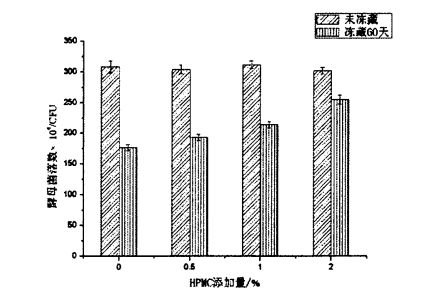
It can be seen from Figure 5.2 that there is no significant difference in the number of yeast colonies in samples with different contents of HPMC added without freezing treatment. This is similar to the result determined by Heitmann, Zannini, & Arendt (2015) [180]. However, after 60 days of freezing, the number of yeast colonies decreased significantly, from 3.08x106 CFU to 1.76x106 CFU (without adding HPMC); from 3.04x106 CFU to 193x106 CFU (adding 0.5% HPMC); ຫຼຸດລົງຈາກ 3.12x106 cfu ກັບ 2.14x106 CFU (ເພີ່ມ 1% HPMC); reduced from 3.02x106 CFU to 2.55x106 CFU (added 2% HPMC). By comparison, it can be found that the freezing storage environment stress led to the decrease of the yeast colony number, but with the increase of HPMC addition, the degree of the decrease of the colony number decreased in turn. This indicates that HPMC can better protect yeast under freezing conditions. The mechanism of protection may be the same as that of glycerol, a commonly used strain antifreeze, mainly by inhibiting the formation and growth of ice crystals and reducing the stress of low temperature environment to yeast. ຮູບທີ 5.3 ແມ່ນ photomicrograph ຖືກເອົາມາຈາກສິ້ນຂອງການທົດສອບເຊື້ອຊາດທີ່ມີຄວາມໄວສູງສຸດຫຼັງຈາກກຽມພ້ອມແລະການກວດກາກ້ອງຈຸລະທັດເຊິ່ງສອດຄ່ອງກັບເຊື້ອລາພາຍນອກຂອງເຊື້ອລາ.
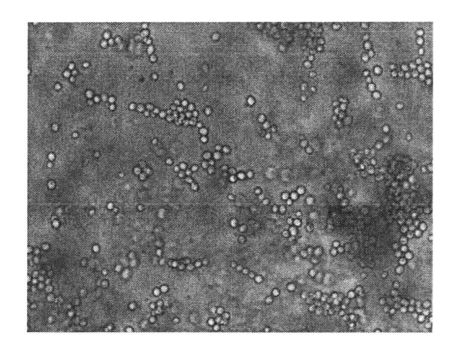
Glutathione ແມ່ນສານປະສົມ tripeptide ປະກອບດ້ວຍກົດ glutamic, cysteine ແລະ glycine, ແລະມີສອງປະເພດ: ຫຼຸດລົງແລະຜຸພັງ. When the yeast cell structure is destroyed and died, the permeability of the cells increases, and the intracellular glutathione is released to the outside of the cell, and it is reductive. It is particularly worth noting that reduced glutathione will reduce the disulfide bonds (-SS-) formed by the cross-linking of gluten proteins, breaking them to form free sulfhydryl groups (.SH), which in turn affects the dough network structure. stability and integrity, and ultimately lead to the deterioration of the quality of fermented flour products. ໂດຍປົກກະຕິແລ້ວ, ພາຍໃຕ້ຄວາມກົດດັນດ້ານສິ່ງແວດລ້ອມ (ເຊັ່ນ: ອຸນຫະພູມສູງ, ຄວາມກົດດັນ osmotic, ແລະອື່ນໆຈະເຮັດໃຫ້ເກີດຄວາມຕ້ານທານກັບຄວາມກົດດັນ, ຫຼືຜະລິດຕະພັນຂອງມັນໃນເວລາດຽວກັນ. When the environmental conditions are suitable for its growth and reproduction again, then restore the metabolism and proliferation vitality. However, some yeasts with poor stress resistance or strong metabolic activity will still die if they are kept in a frozen storage environment for a long time.
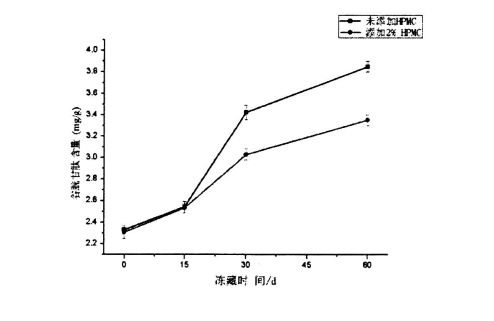
ຕົວເລກ 5.4 ຜົນກະທົບຂອງການເພີ່ມ HPMC ແລະການເກັບຮັກສາ frozen ໃນເນື້ອໃນຂອງ glutathione (GSH)
5.4 ບົດສະຫຼຸບ
Yeast is an indispensable and important component in fermented flour products, and its fermentation activity will directly affect the quality of the final product. In this experiment, the protective effect of HPMC on yeast in frozen dough system was evaluated by studying the effect of different HPMC additions on yeast fermentation activity, yeast survival number, and extracellular glutathione content in frozen dough. Through experiments, it was found that the addition of HPMC can better maintain the fermentation activity of the yeast, and reduce the degree of decline in the proofing height of the dough after 60 days of freezing, thus providing a guarantee for the specific volume of the final product; in addition, the addition of HPMC effectively The decrease of yeast survival number was inhibited and the increase rate of reduced glutathione content was reduced, thereby alleviating the damage of glutathione to dough network structure. ນີ້ຊີ້ໃຫ້ເຫັນວ່າ HPMC ສາມາດປົກປ້ອງເຊື້ອລາໂດຍການຍັບຍັ້ງການສ້າງຕັ້ງແລະການເຕີບໃຫຍ່ຂອງນ້ໍາກ້ອນ.
ເວລາໄປສະນີ: Oct-08-2022







